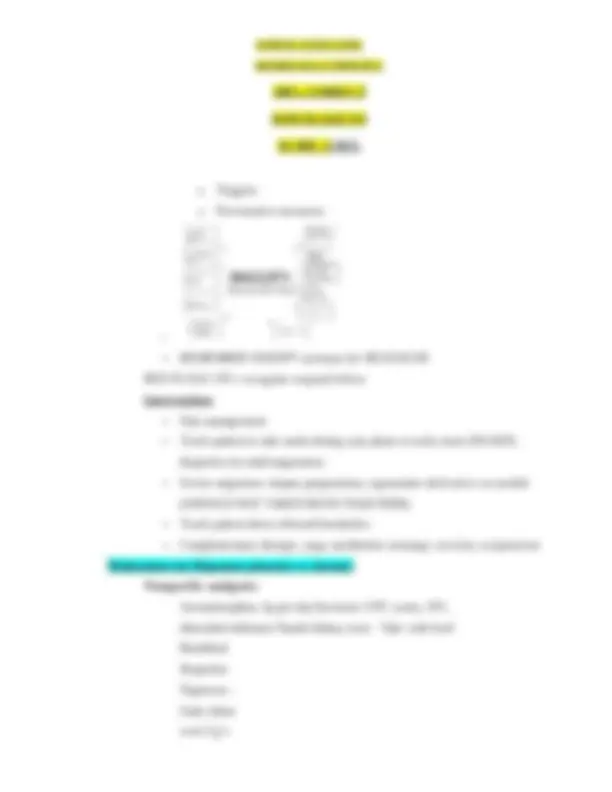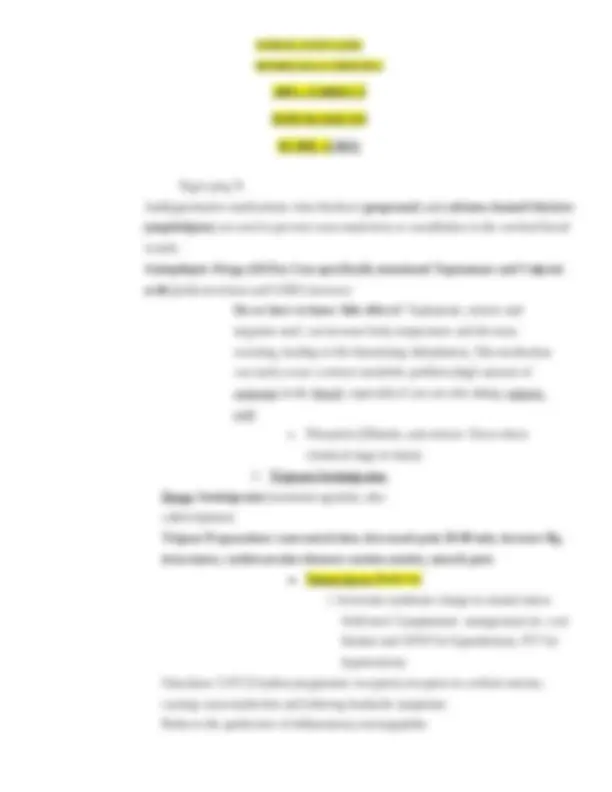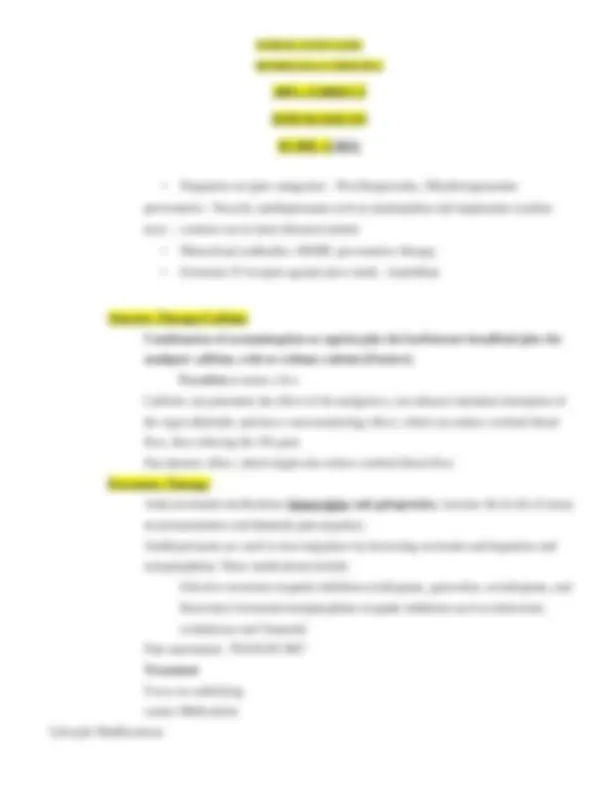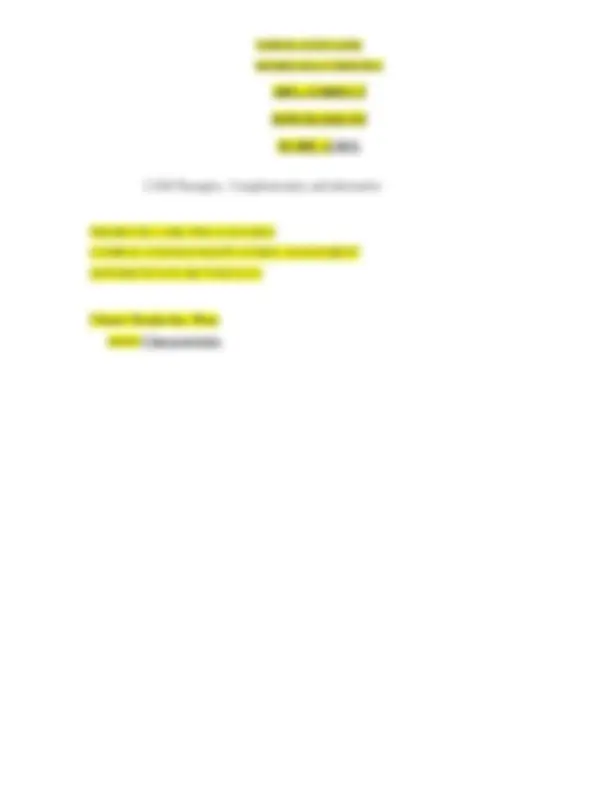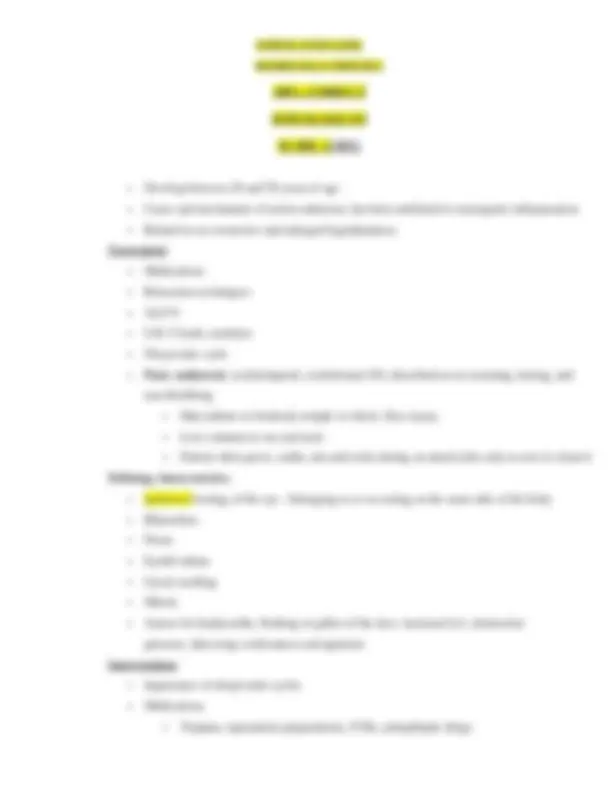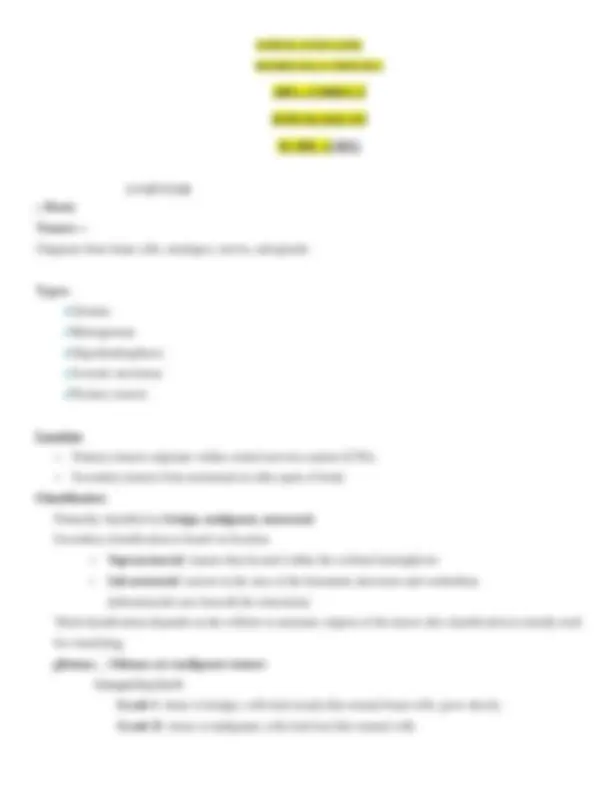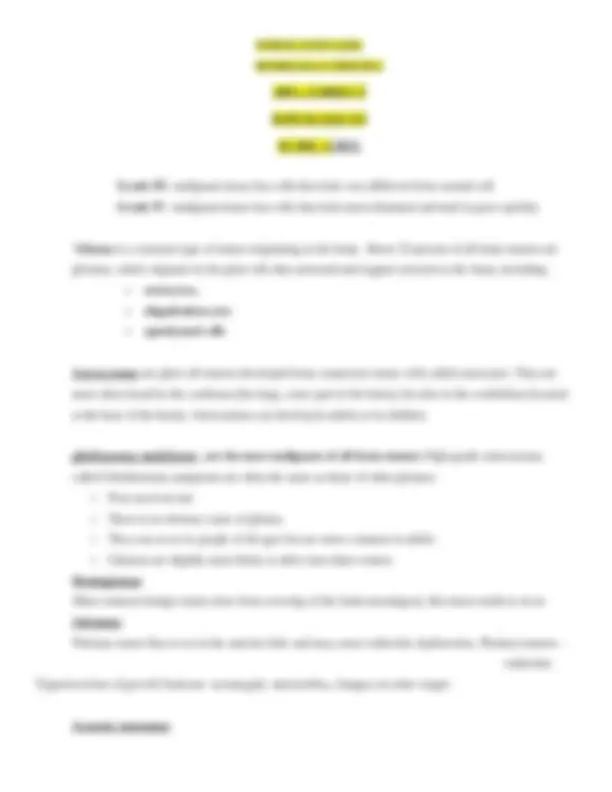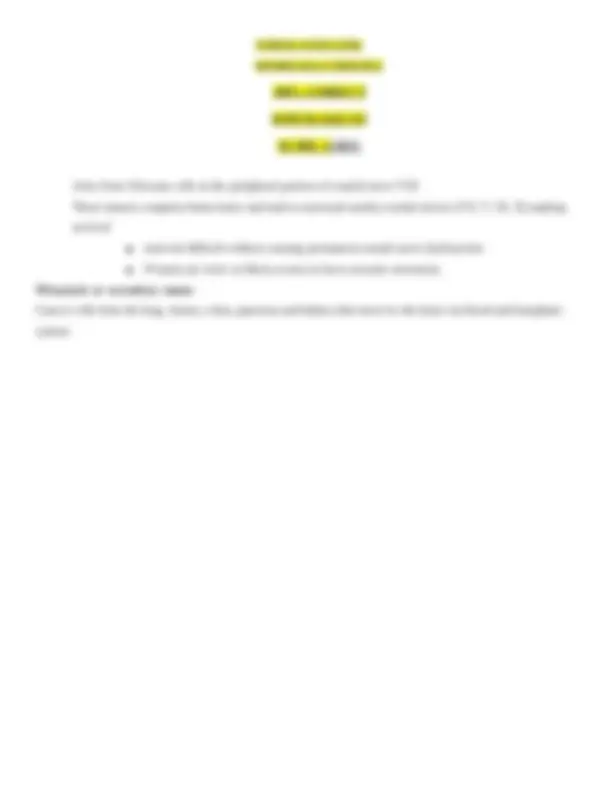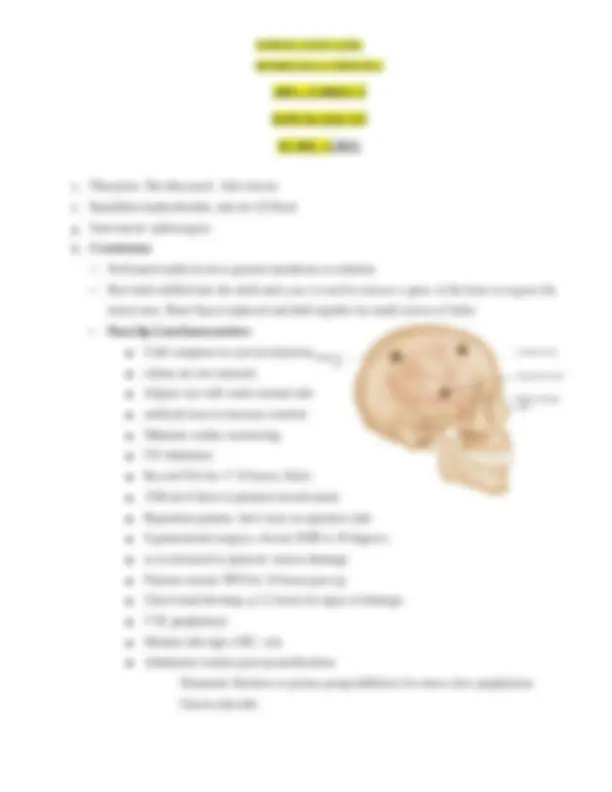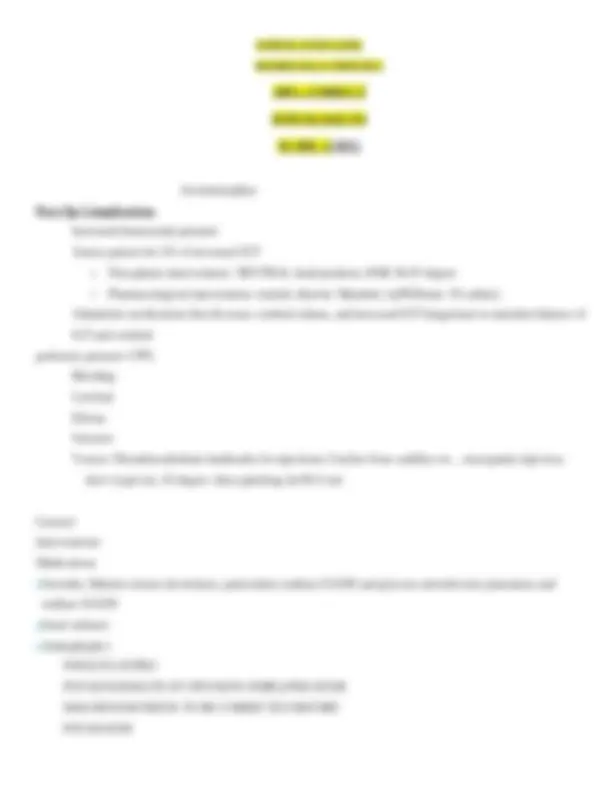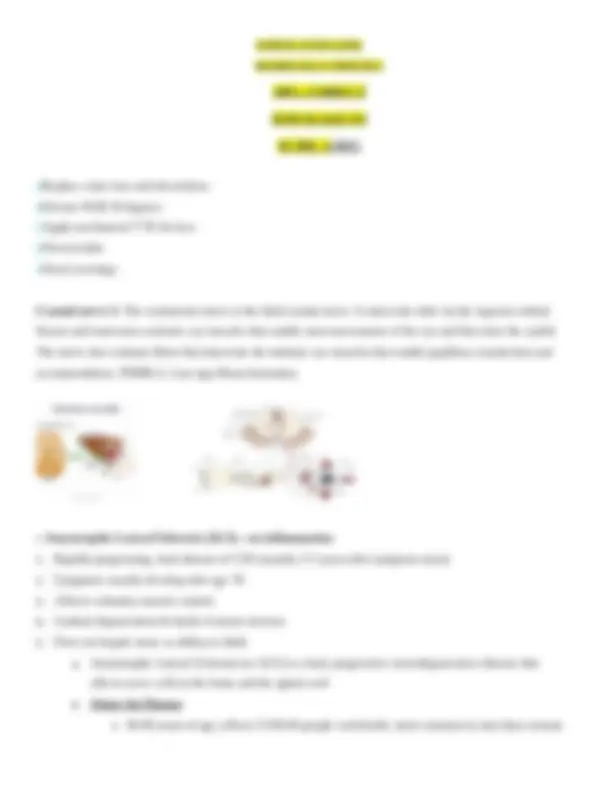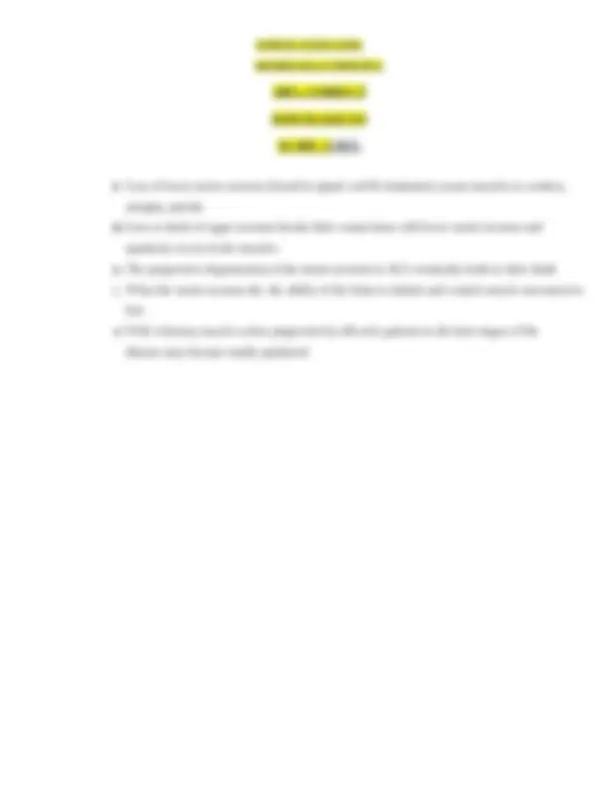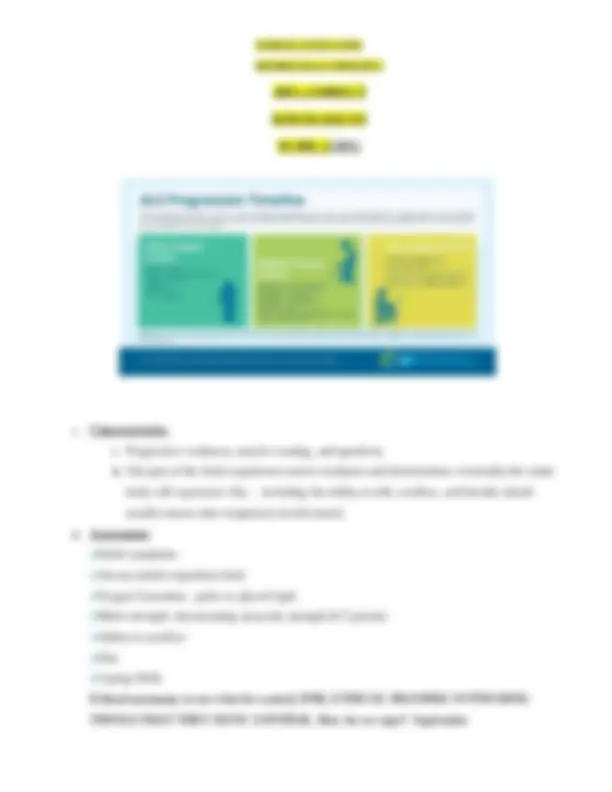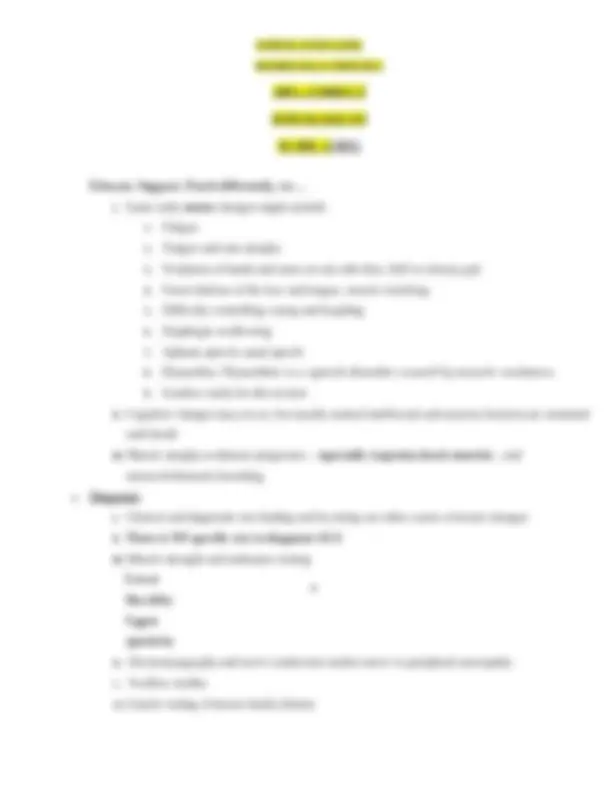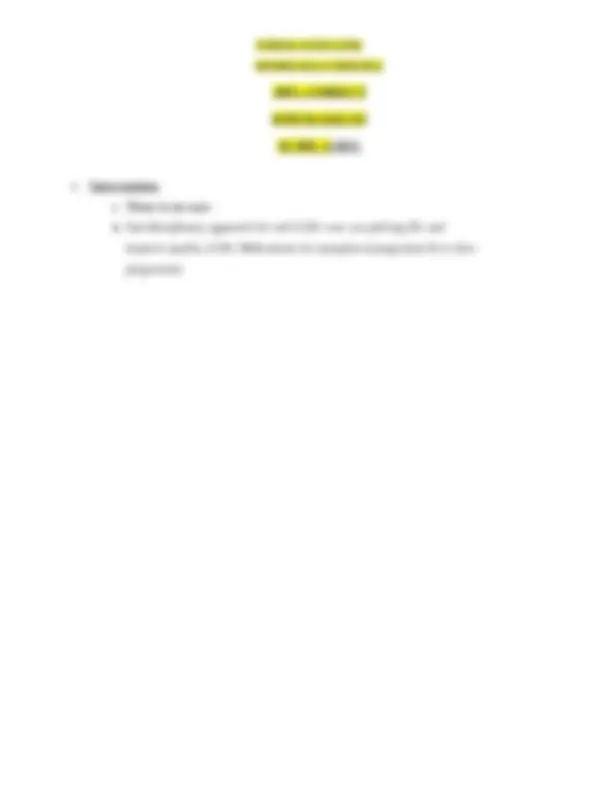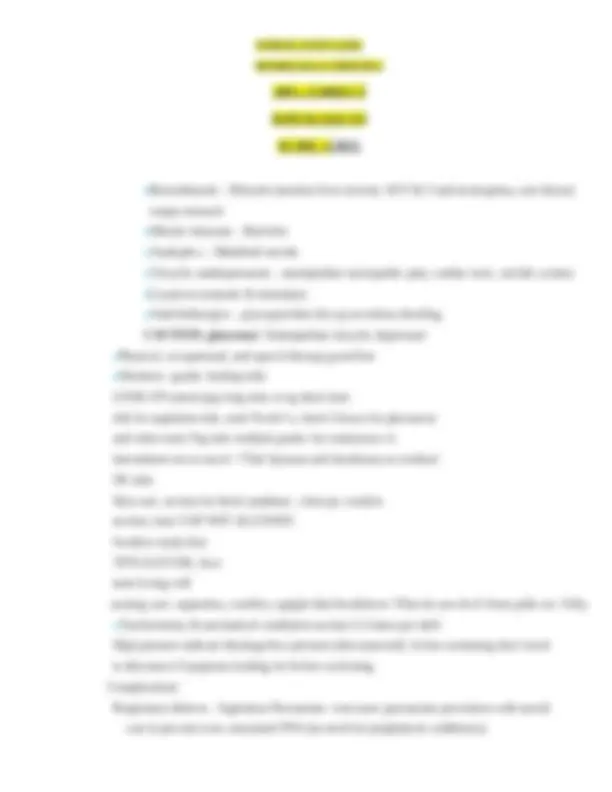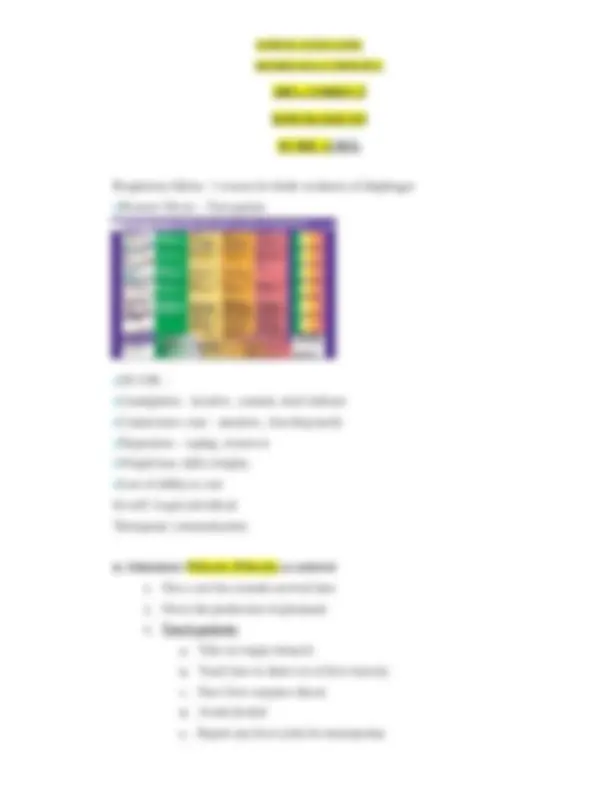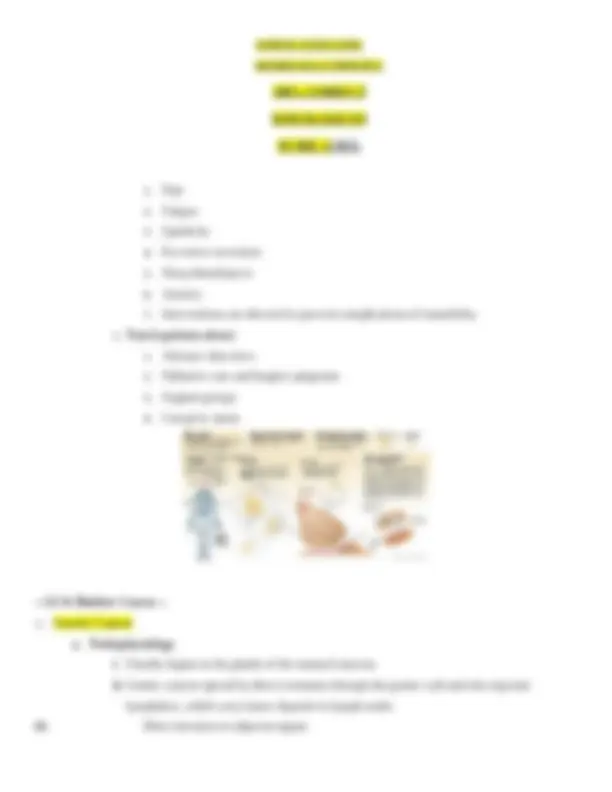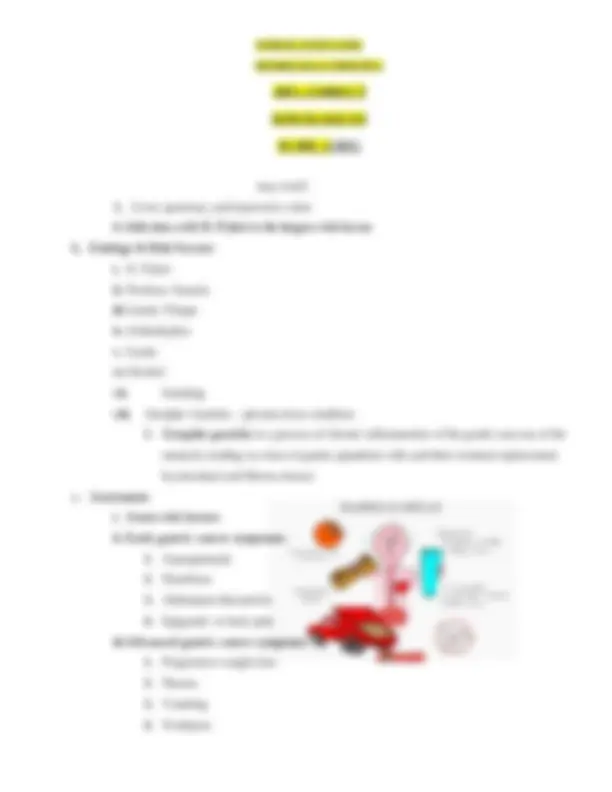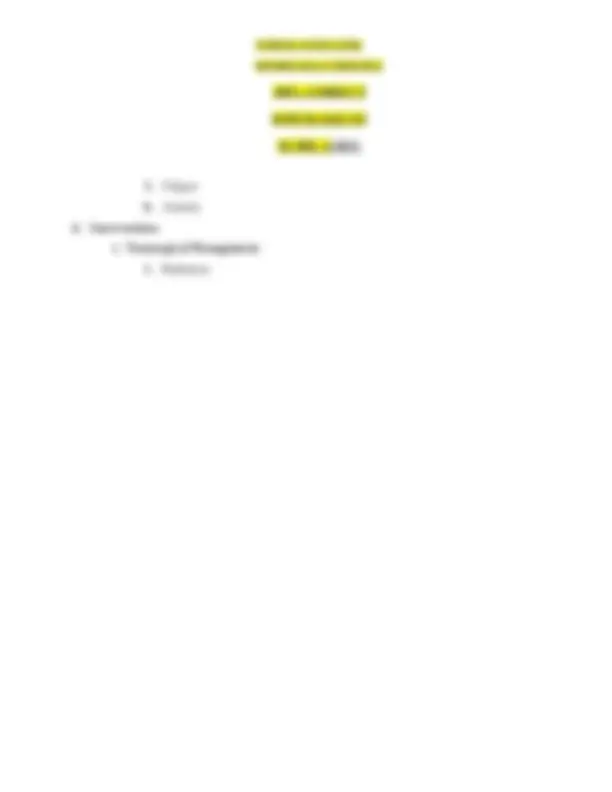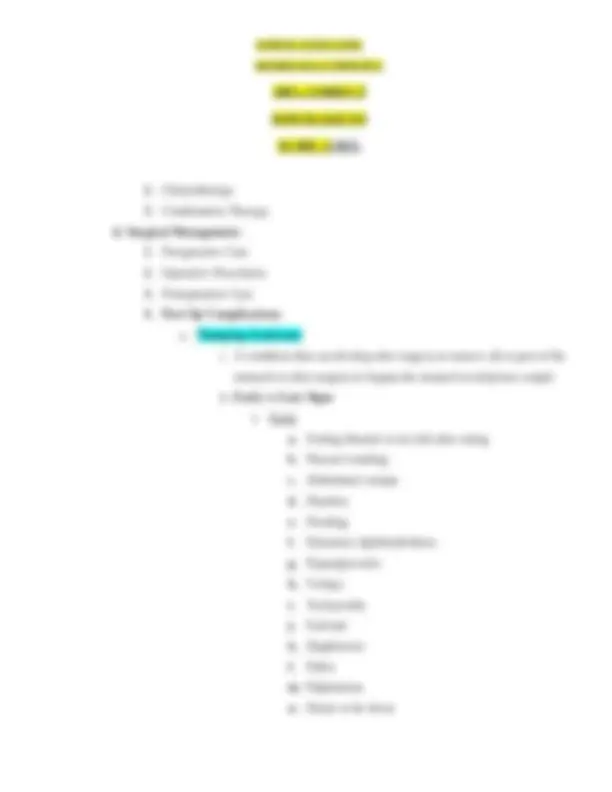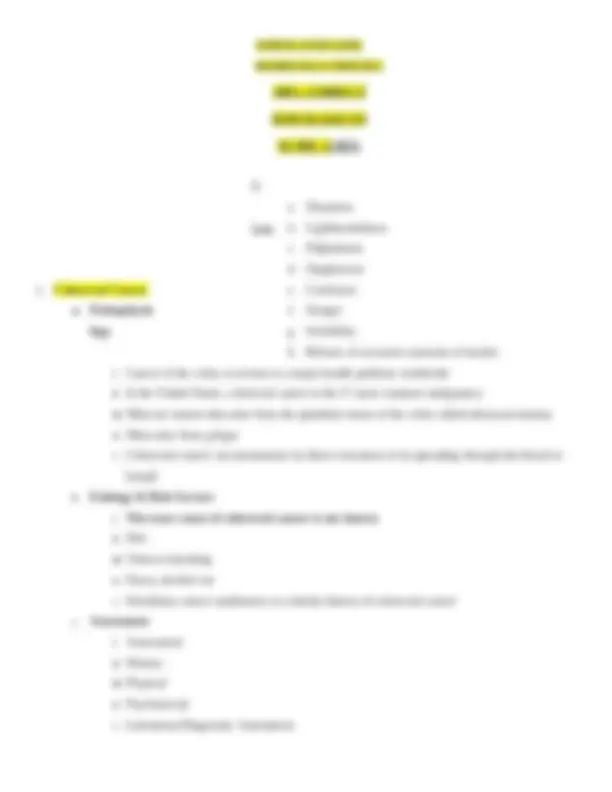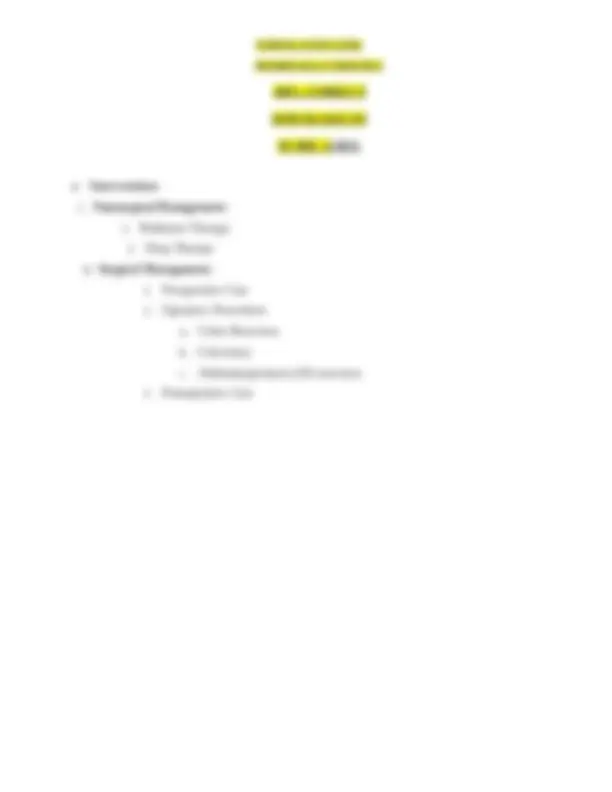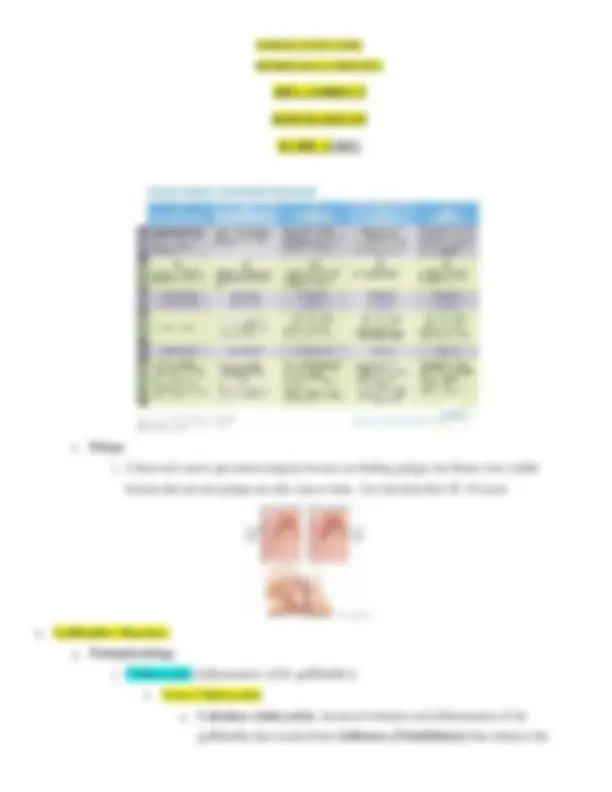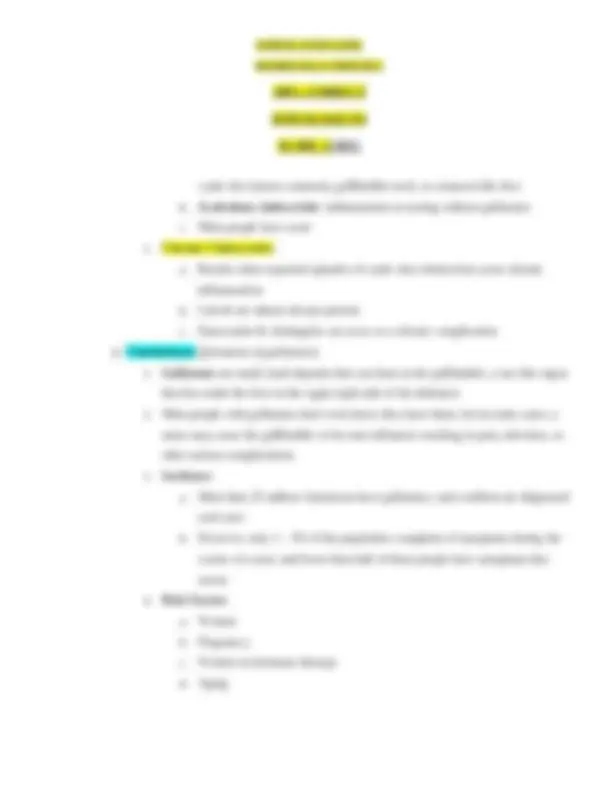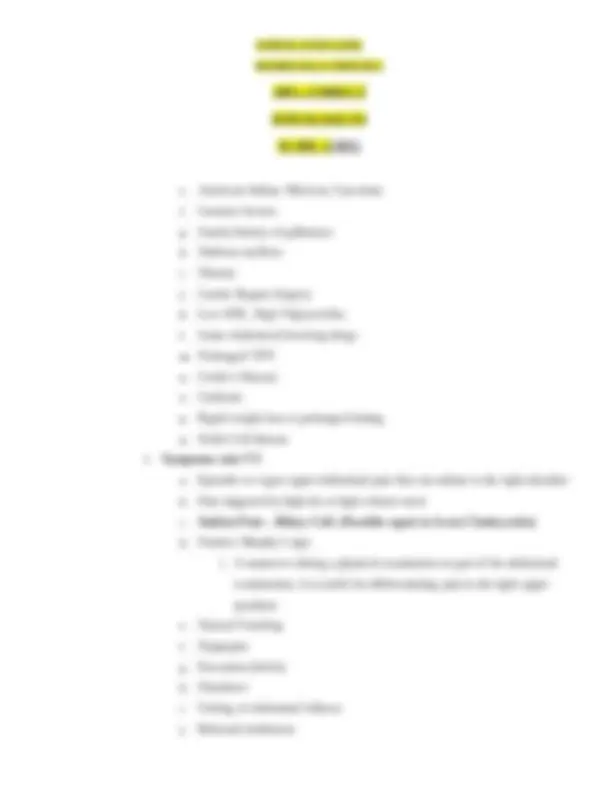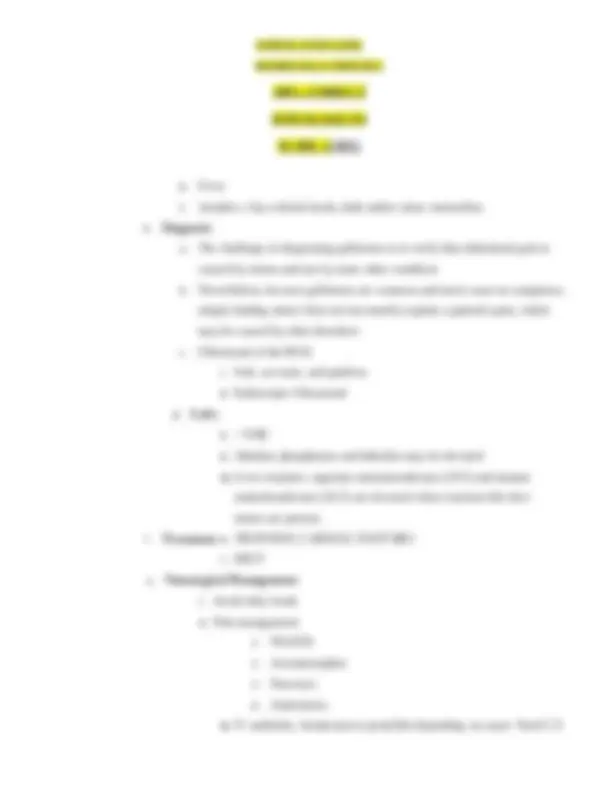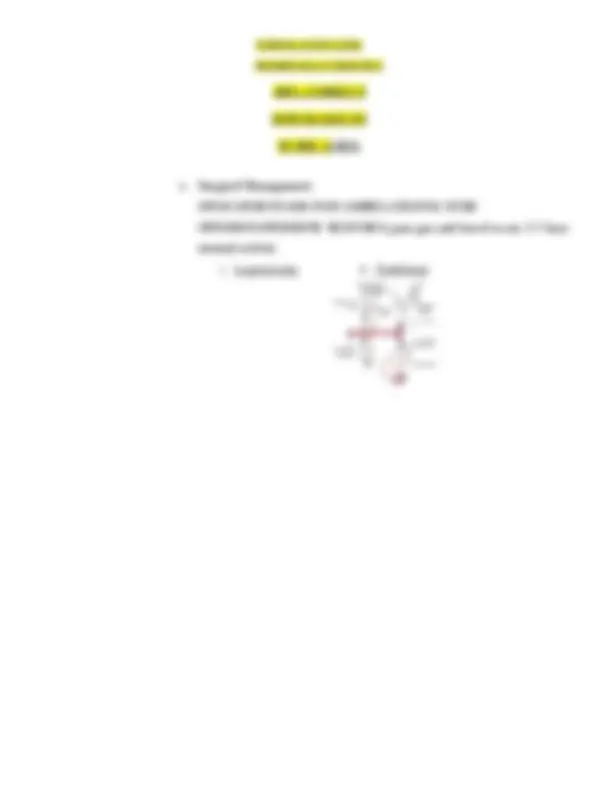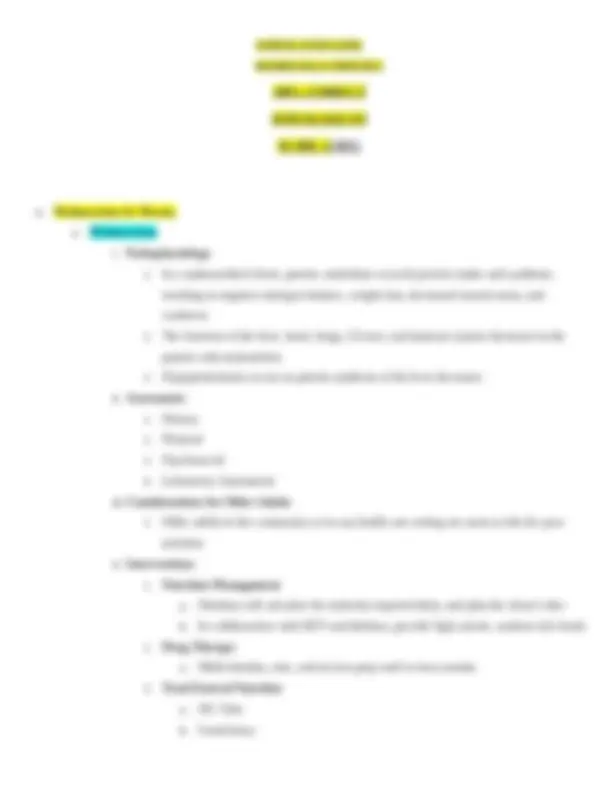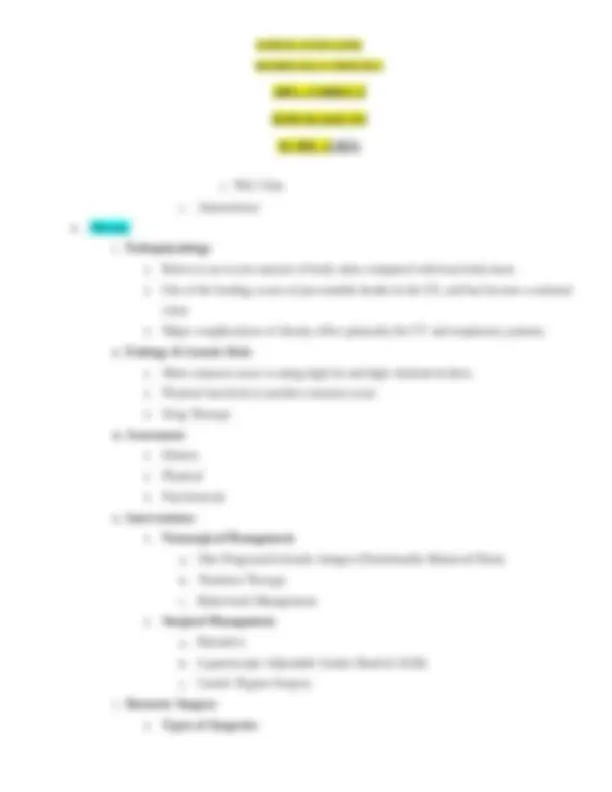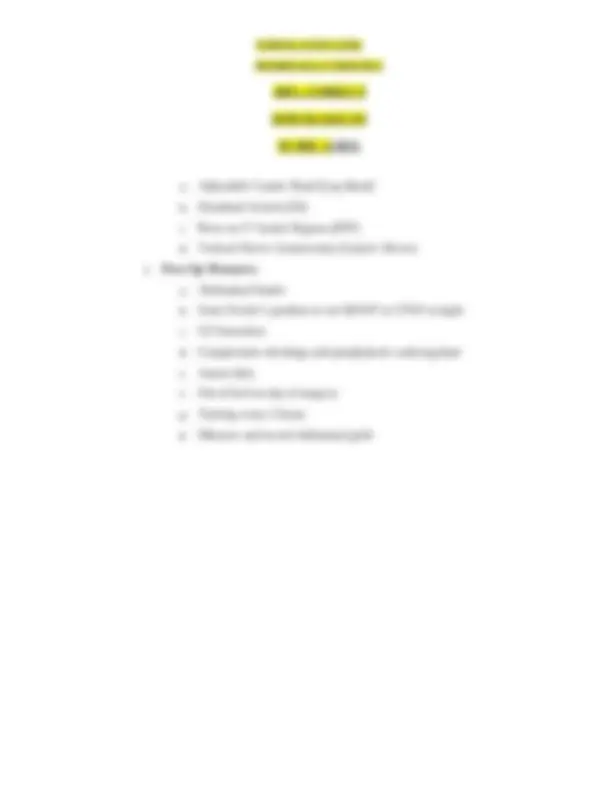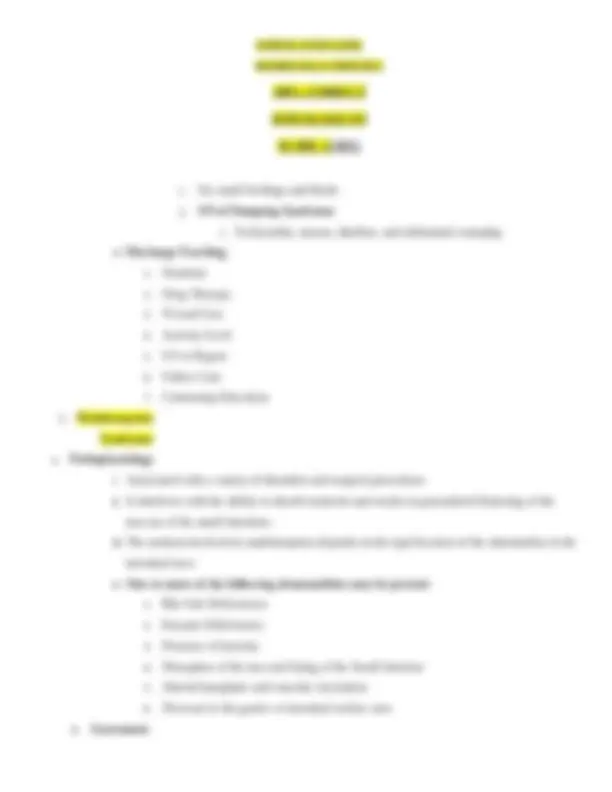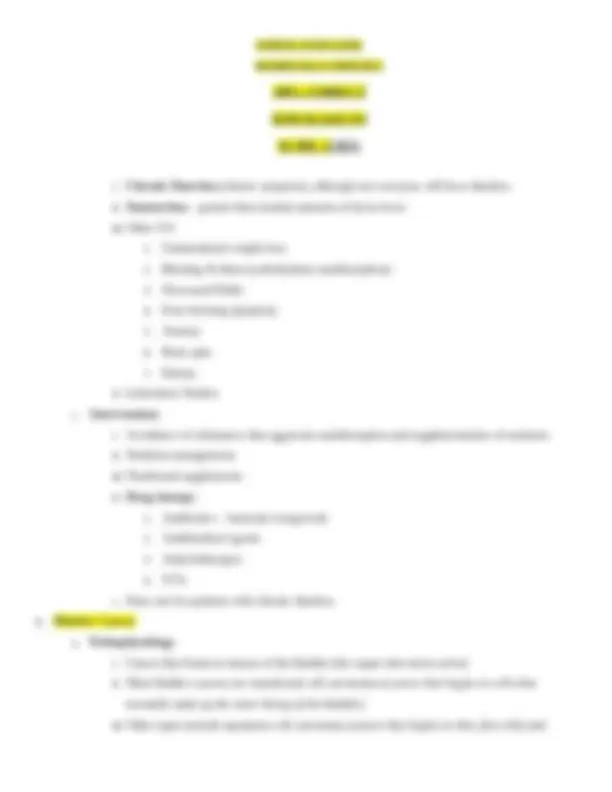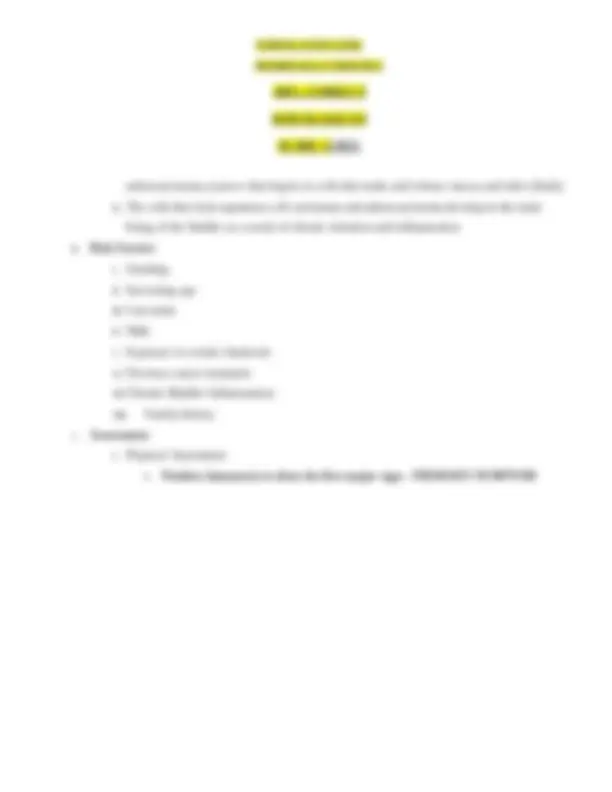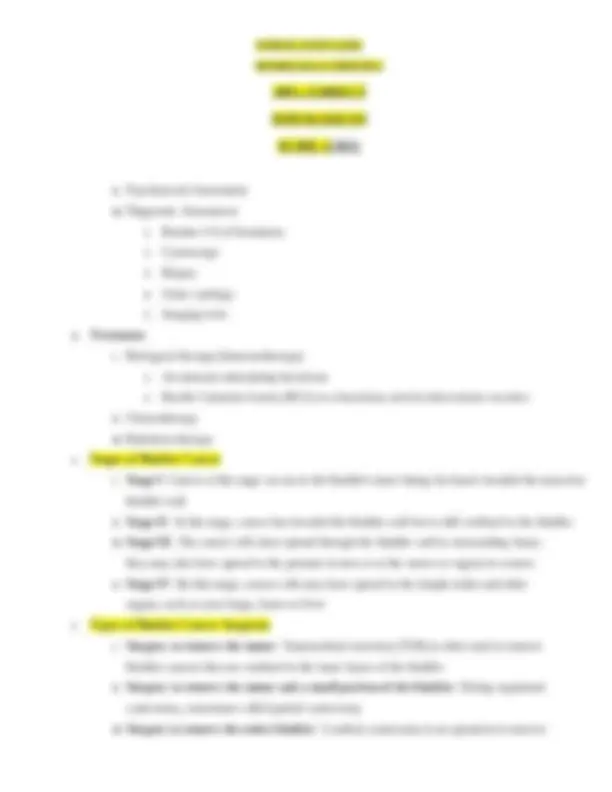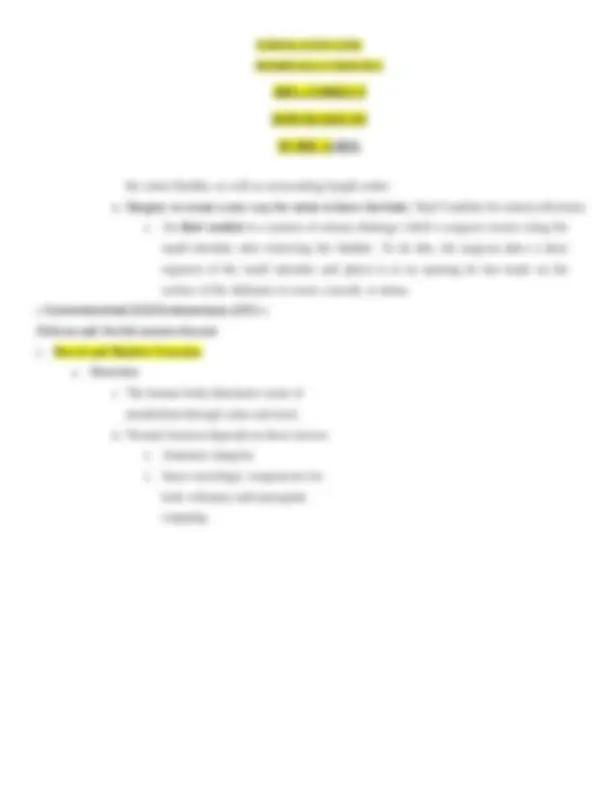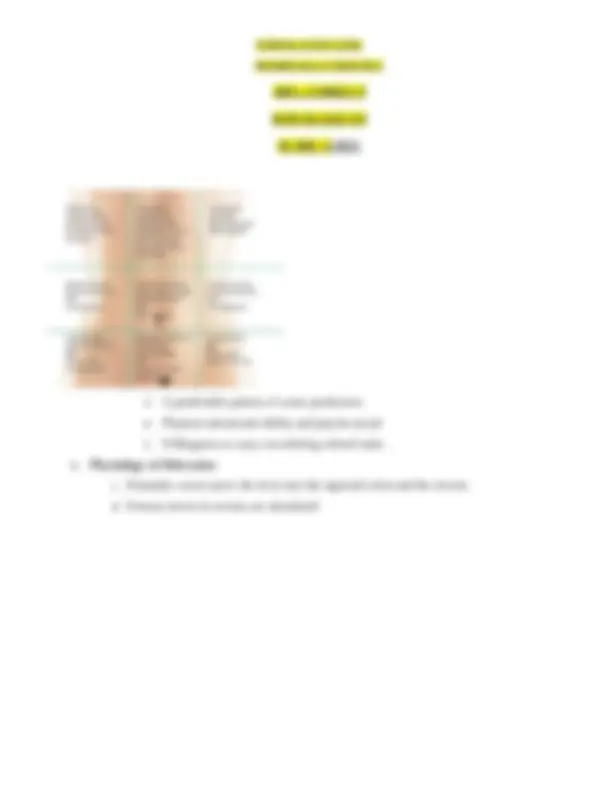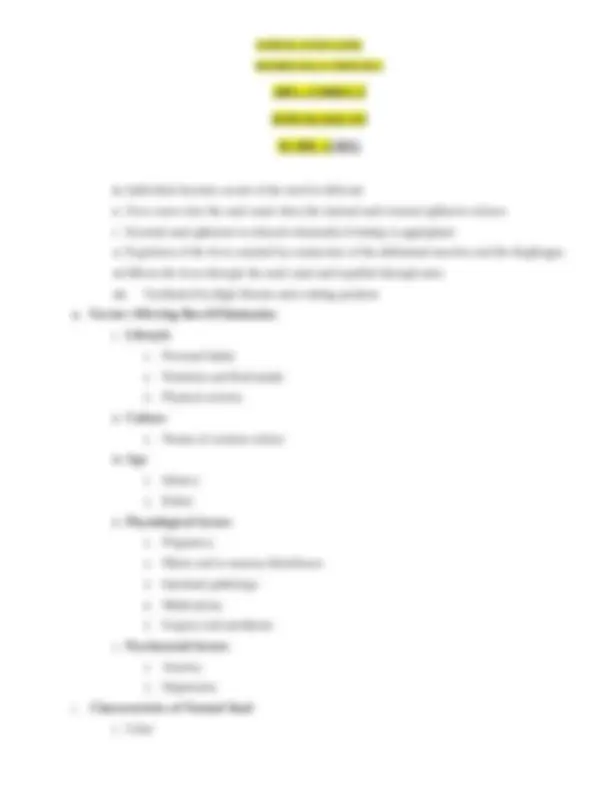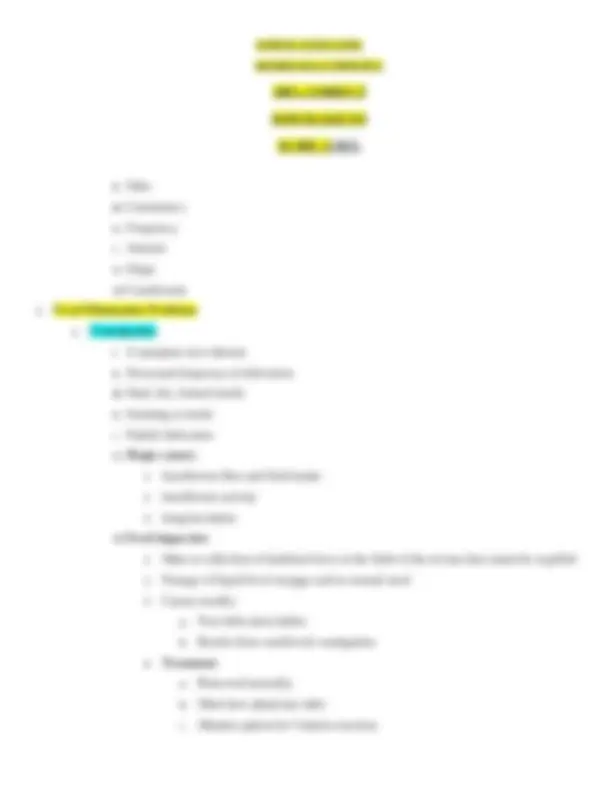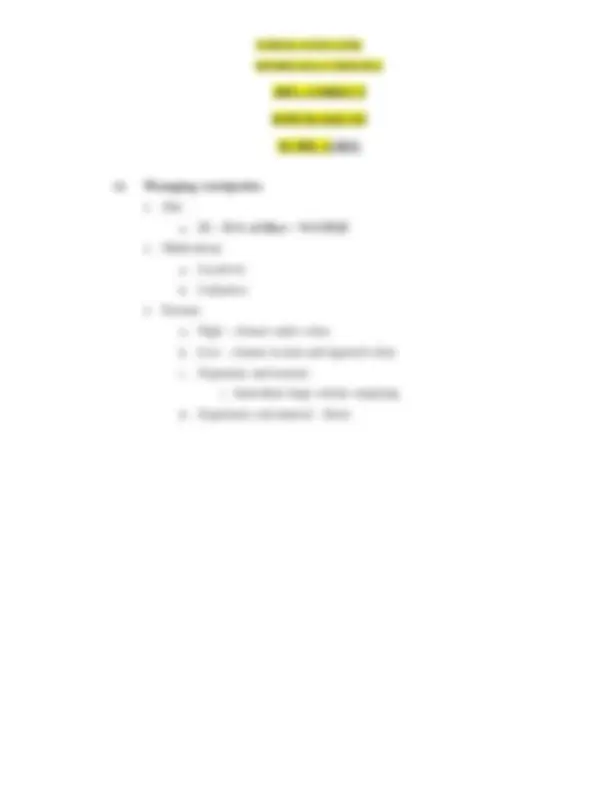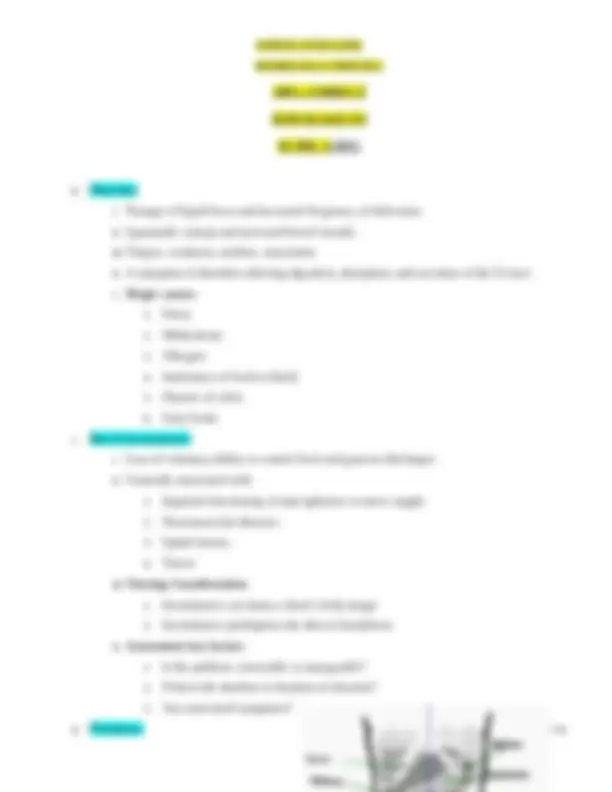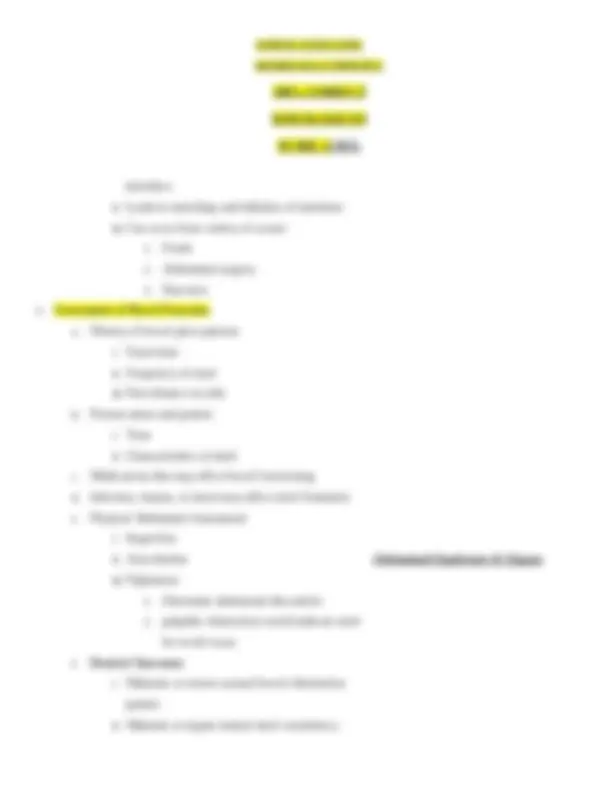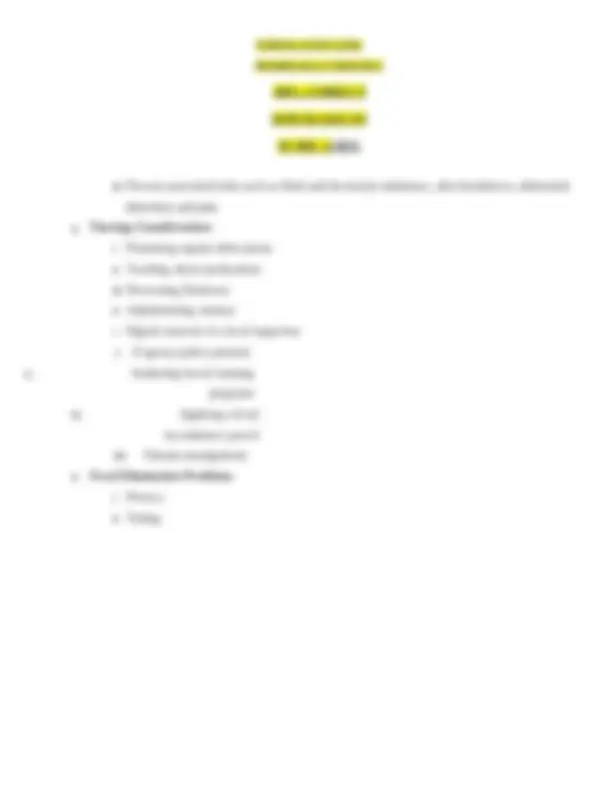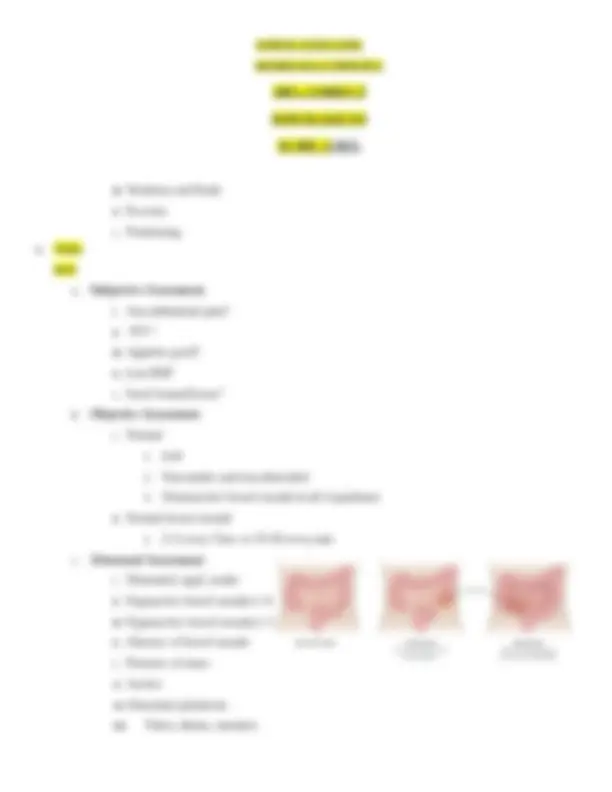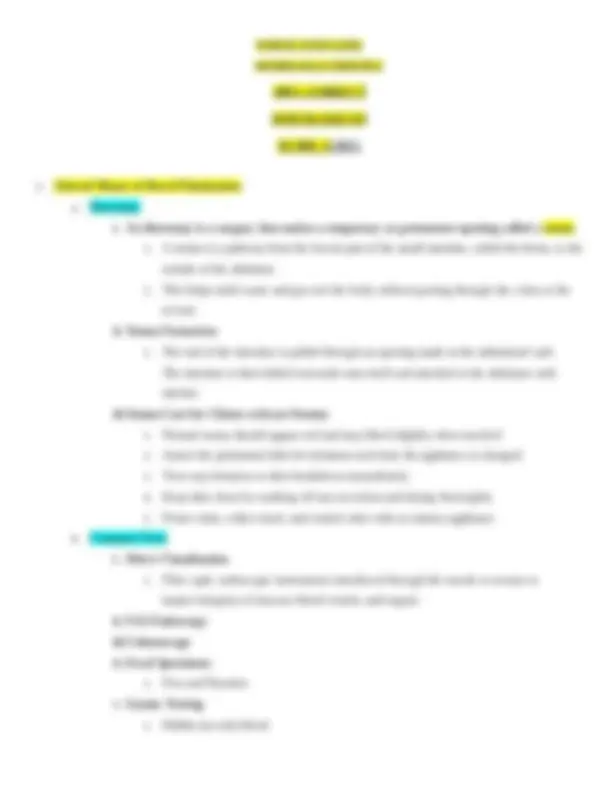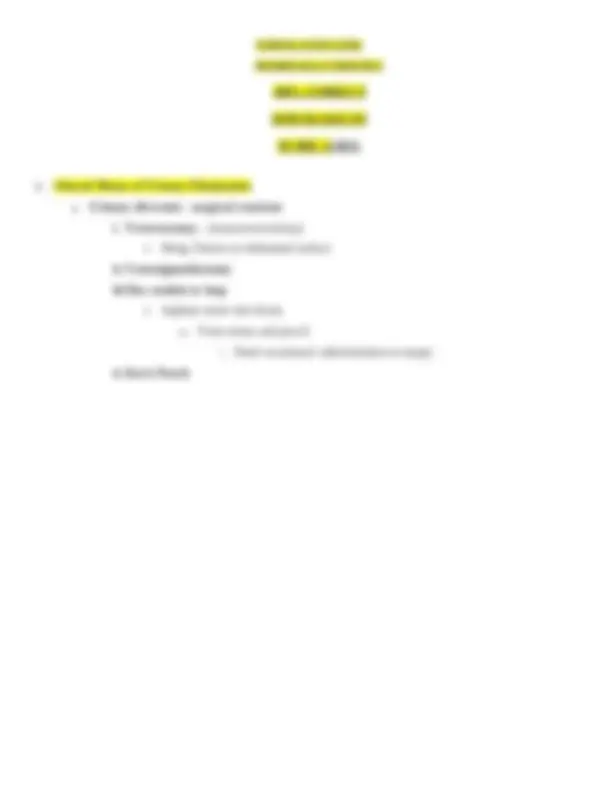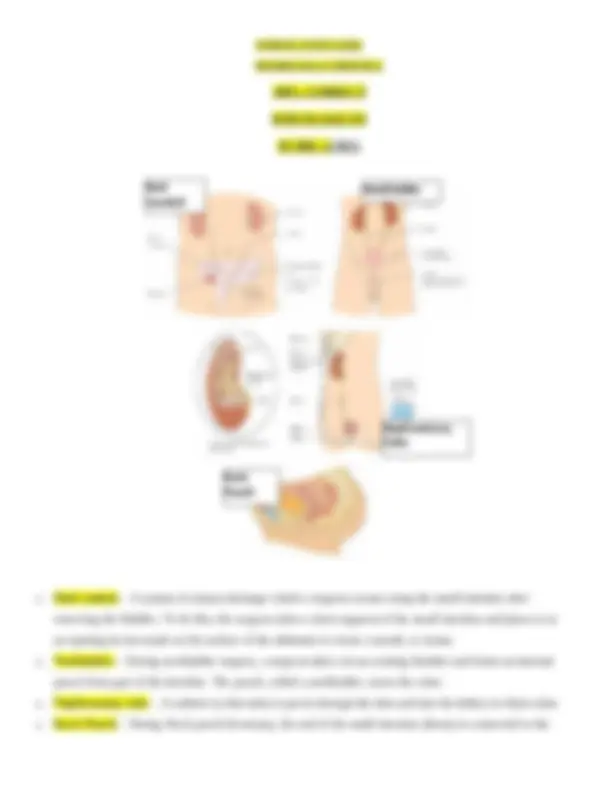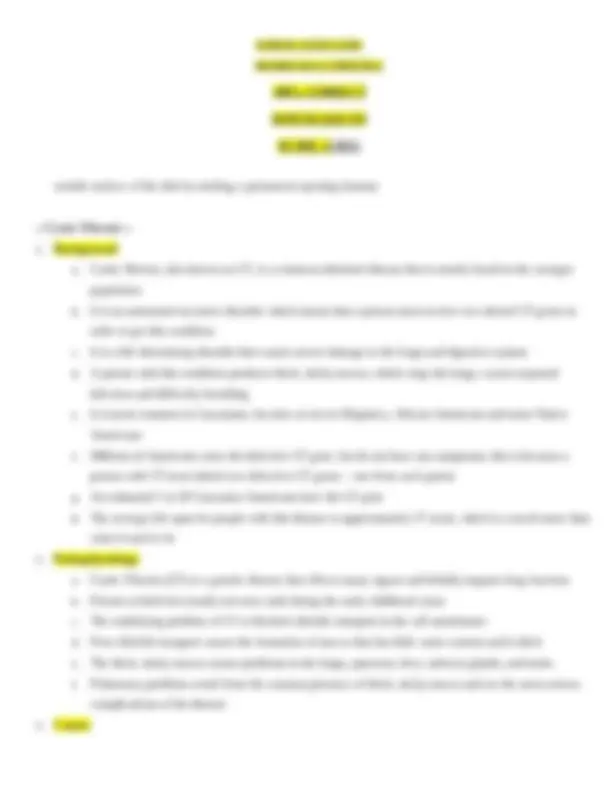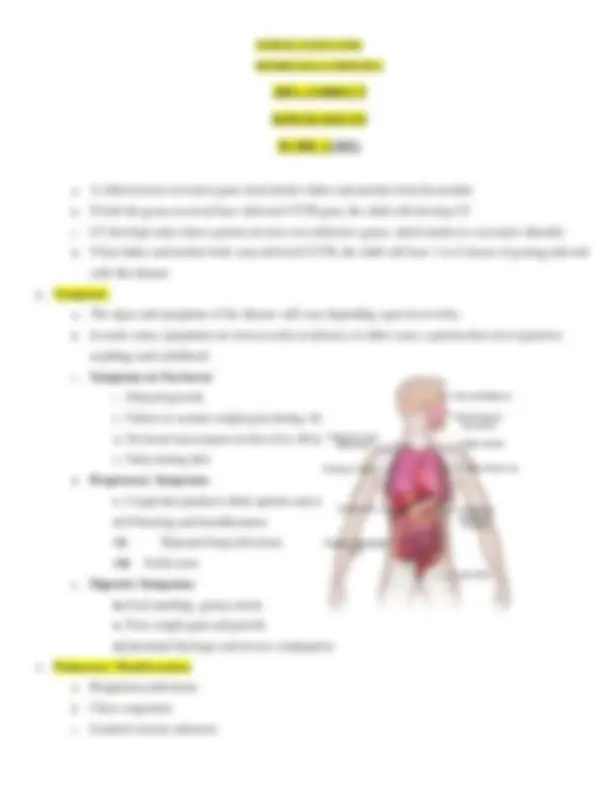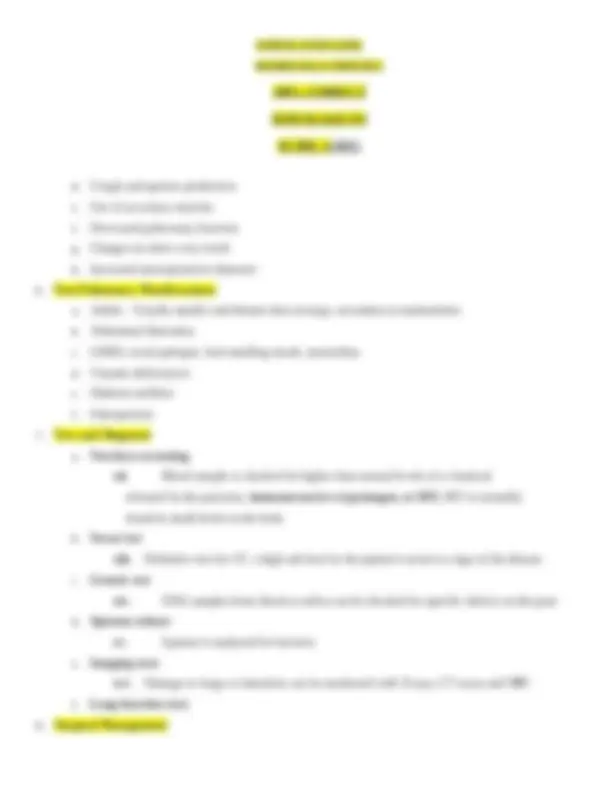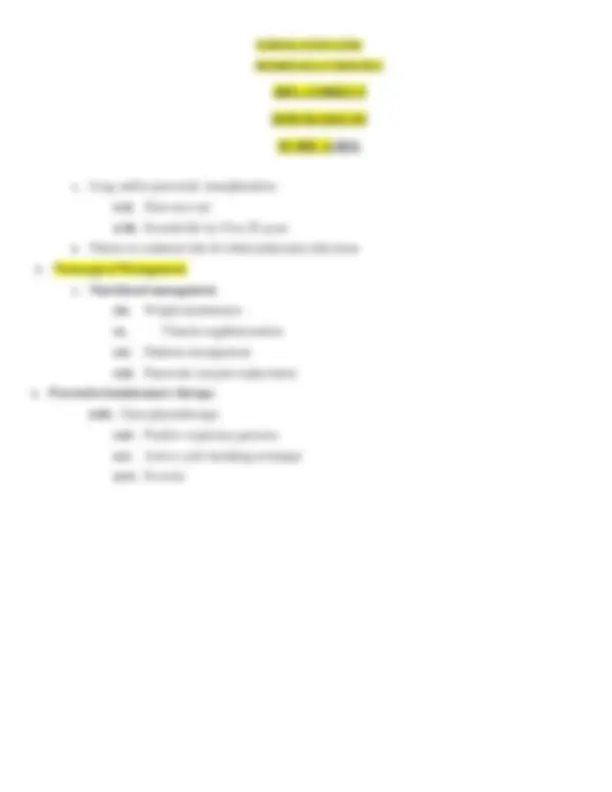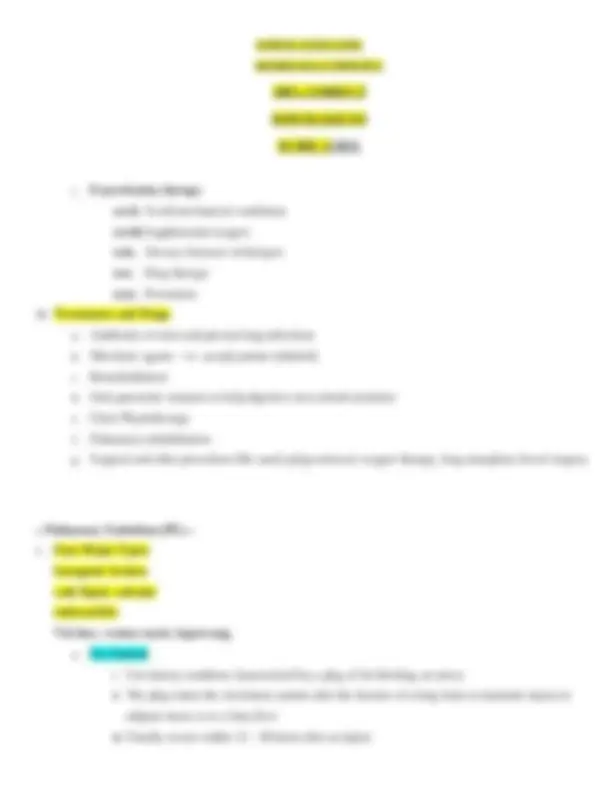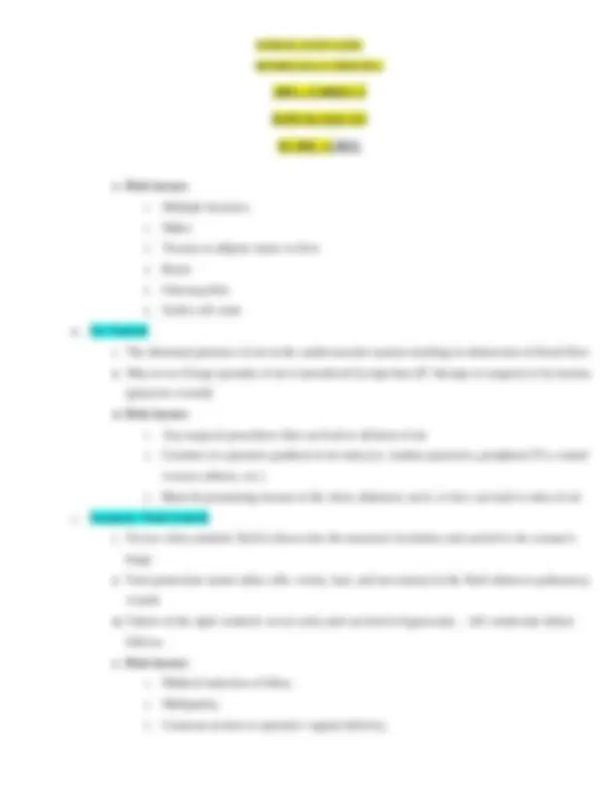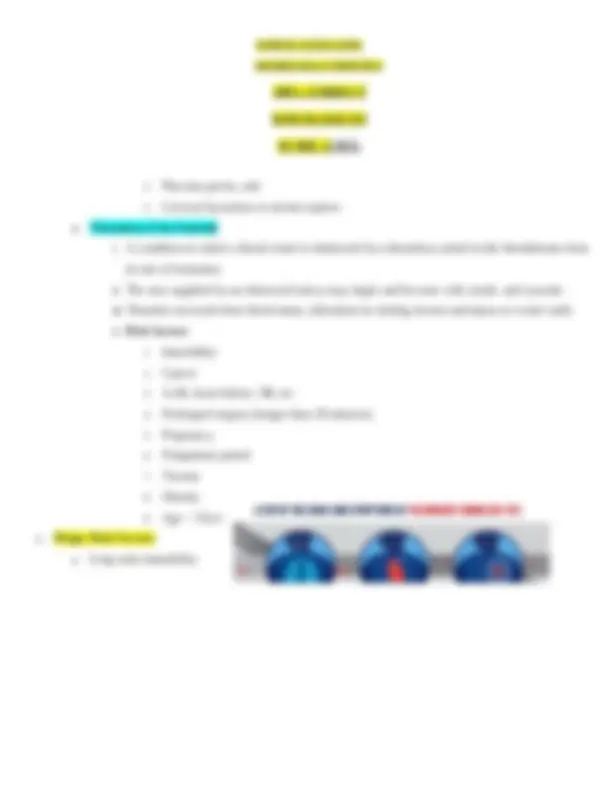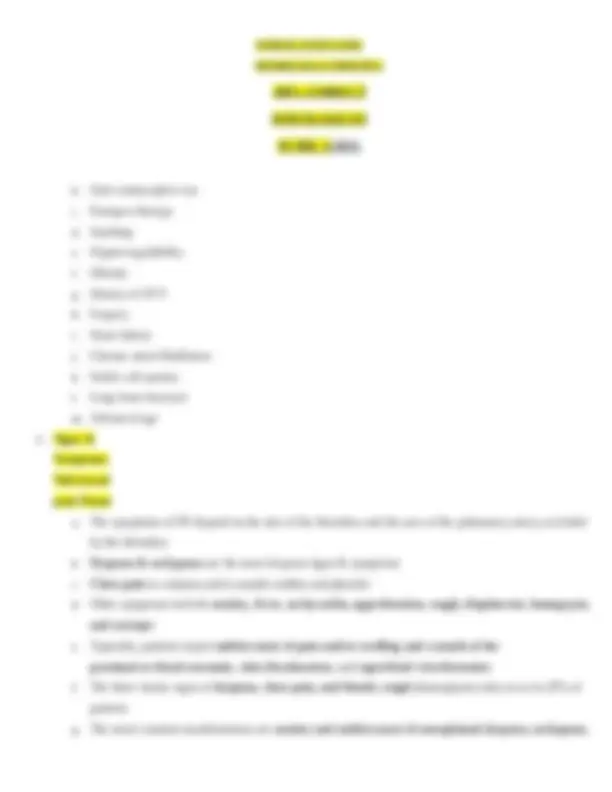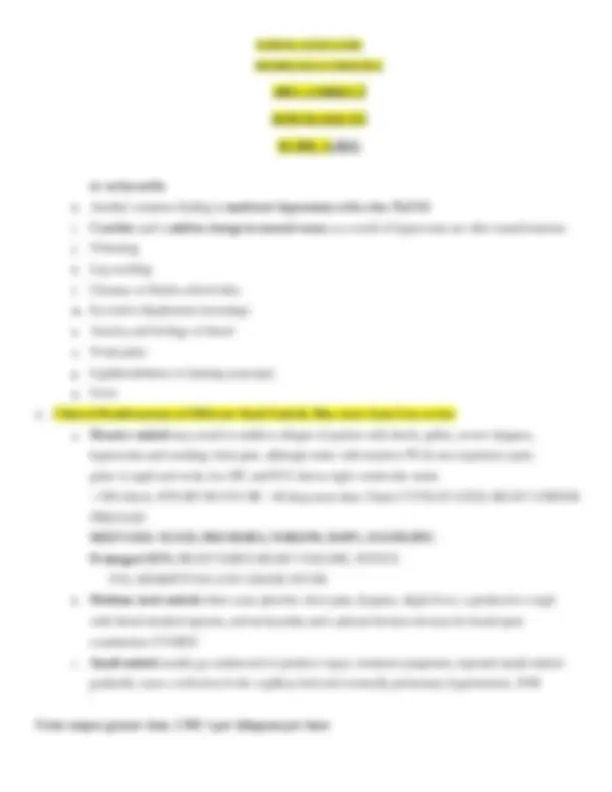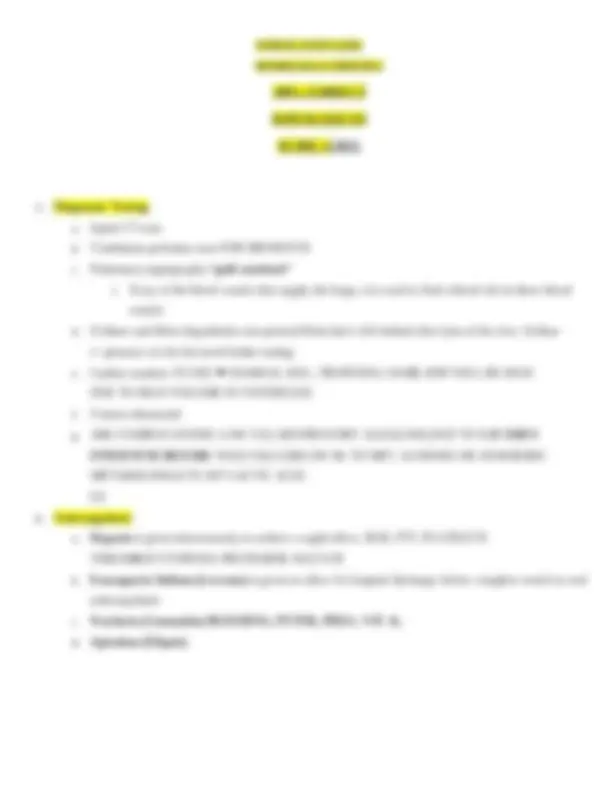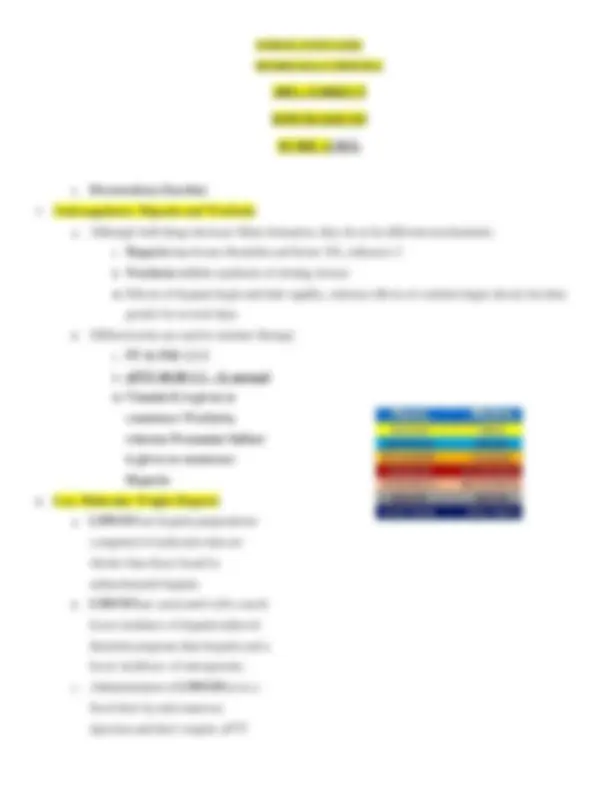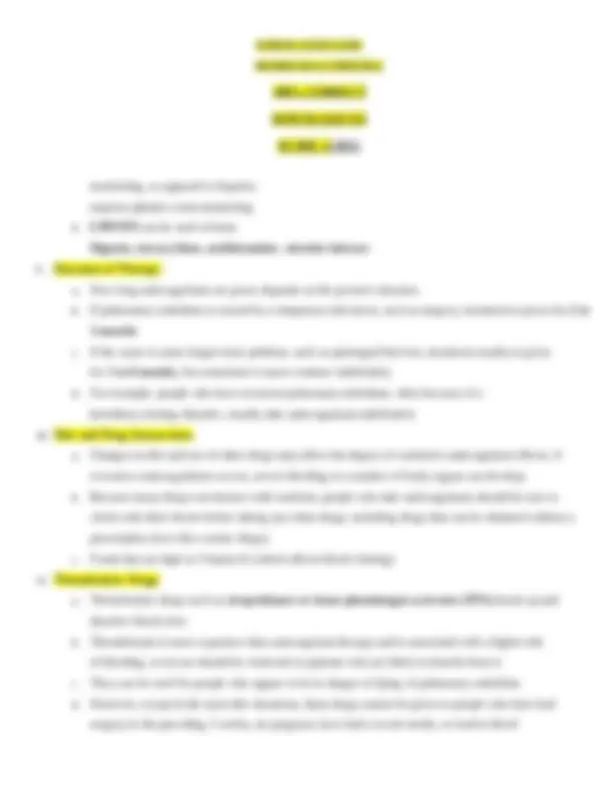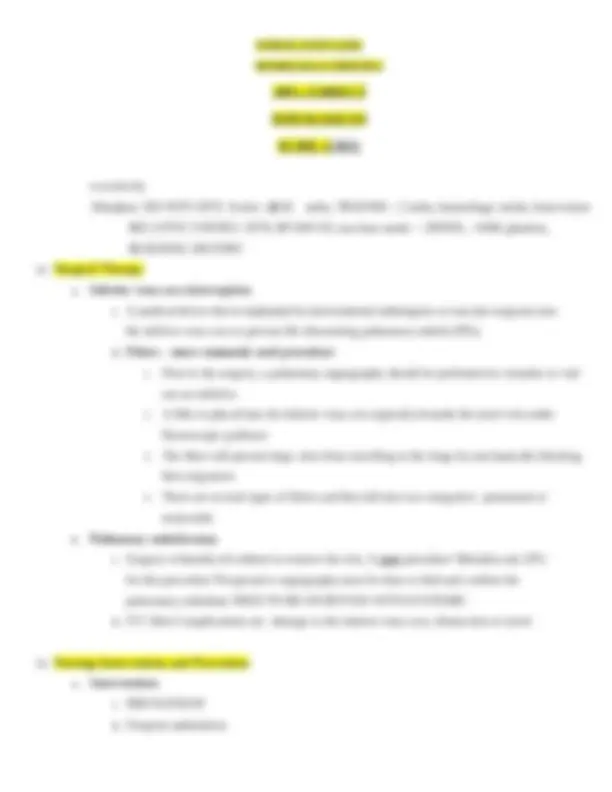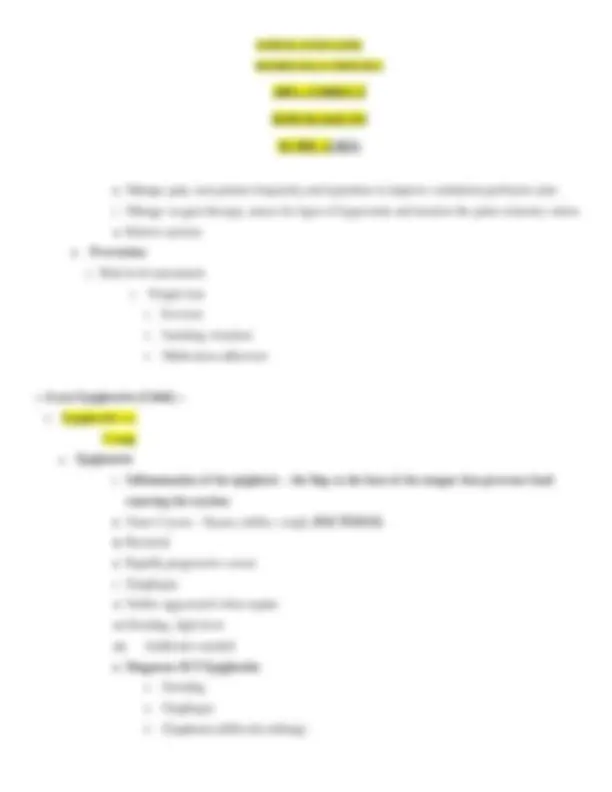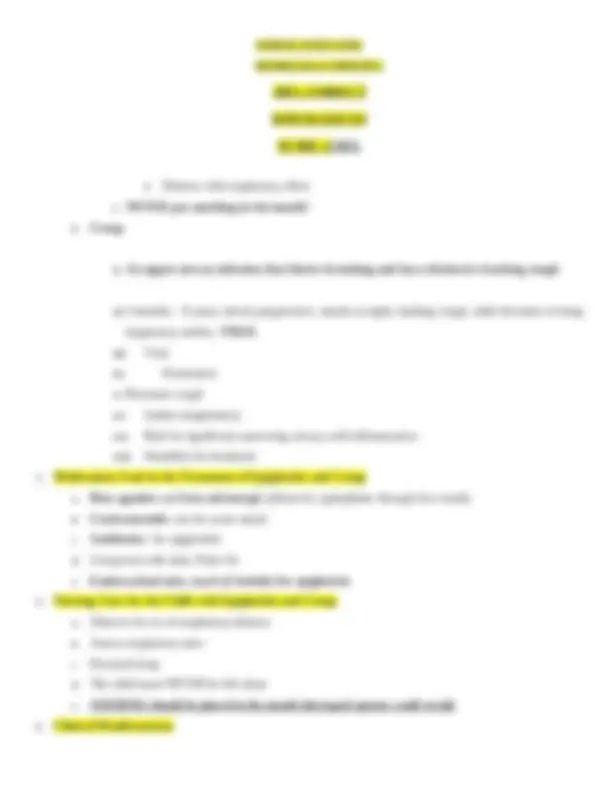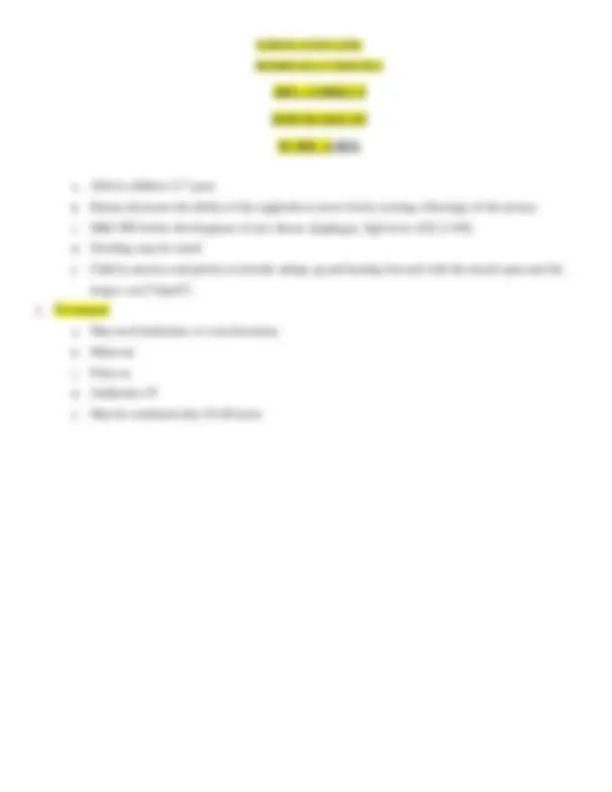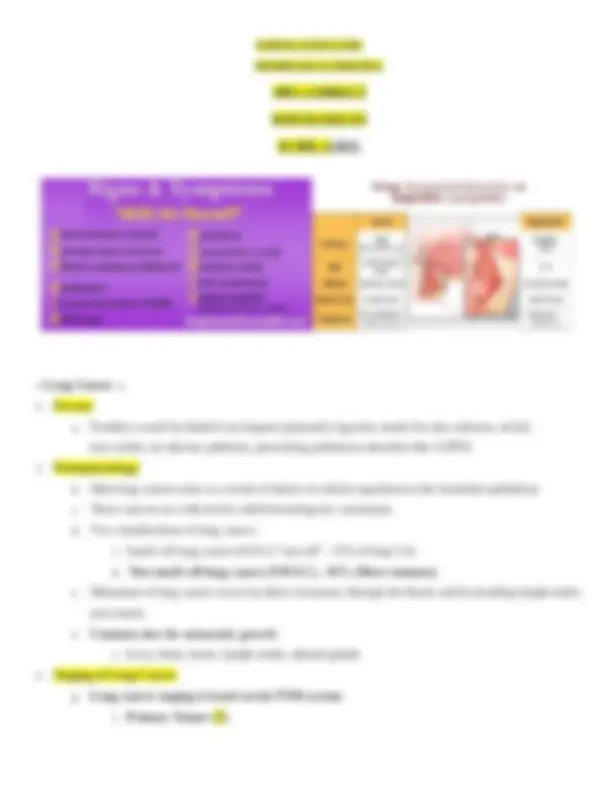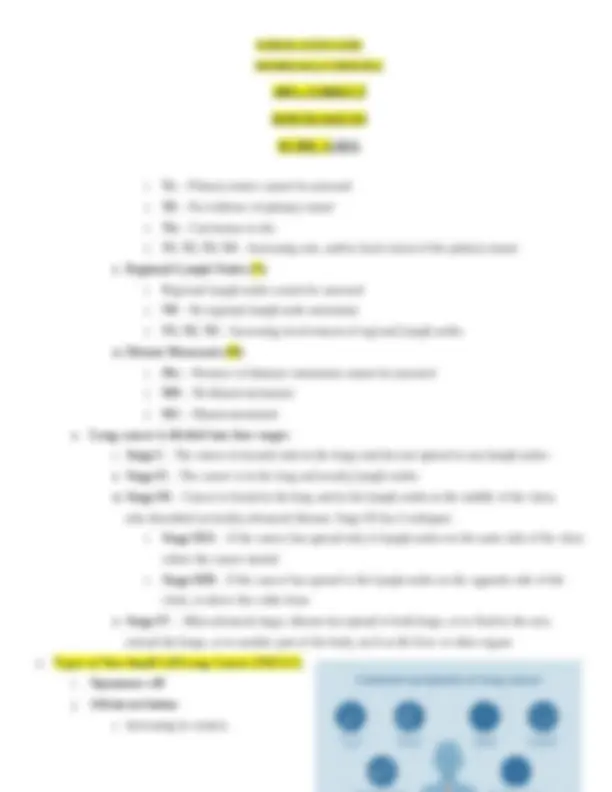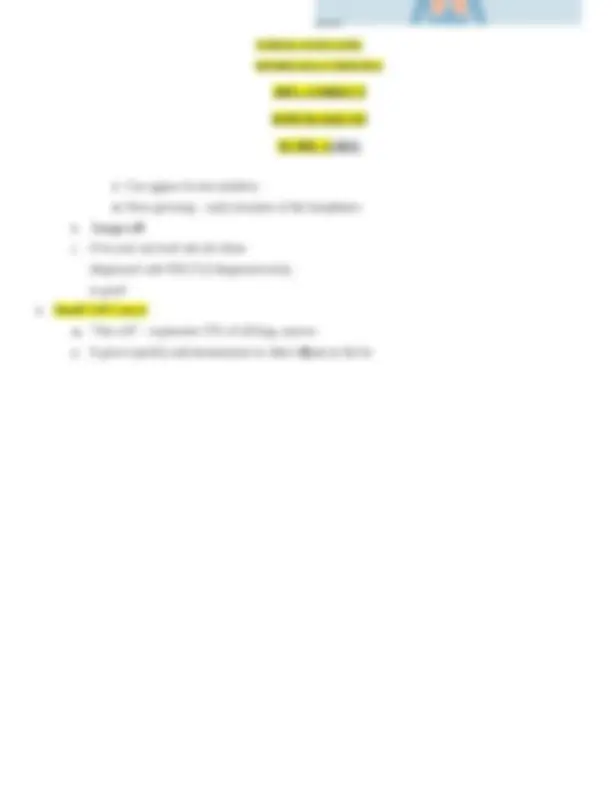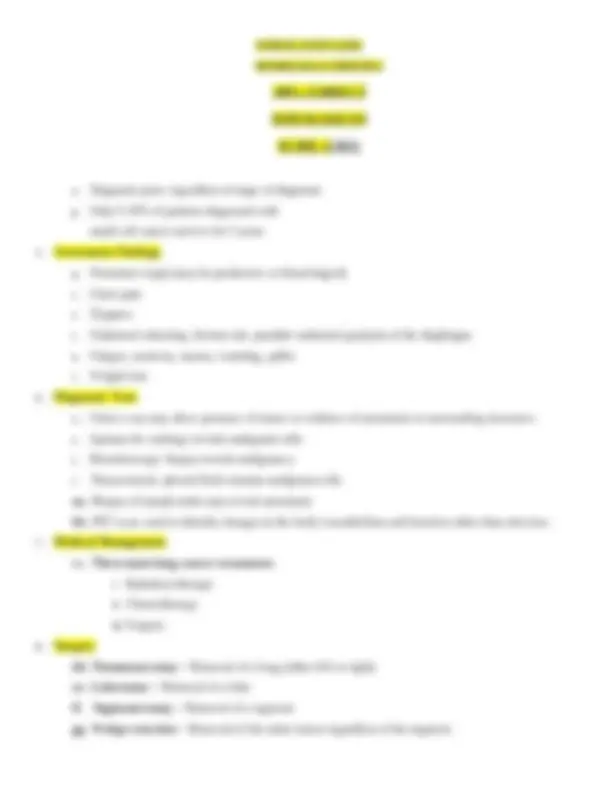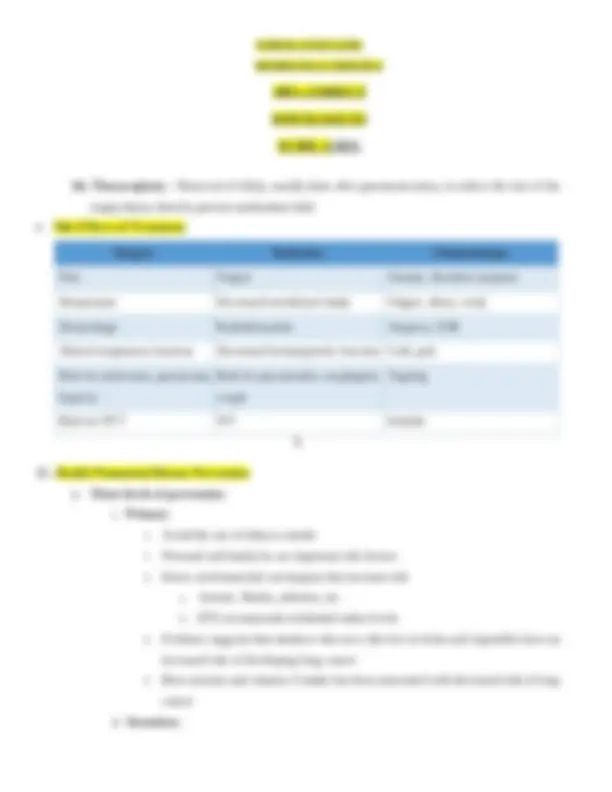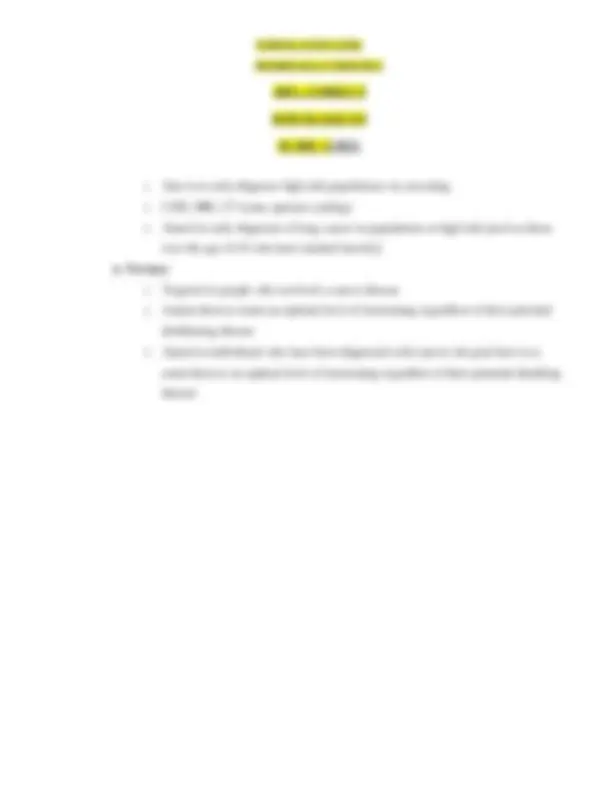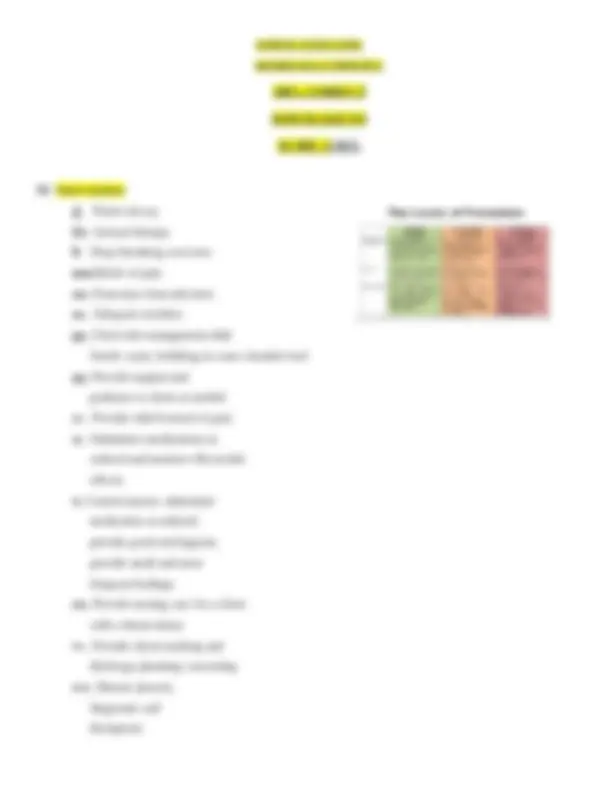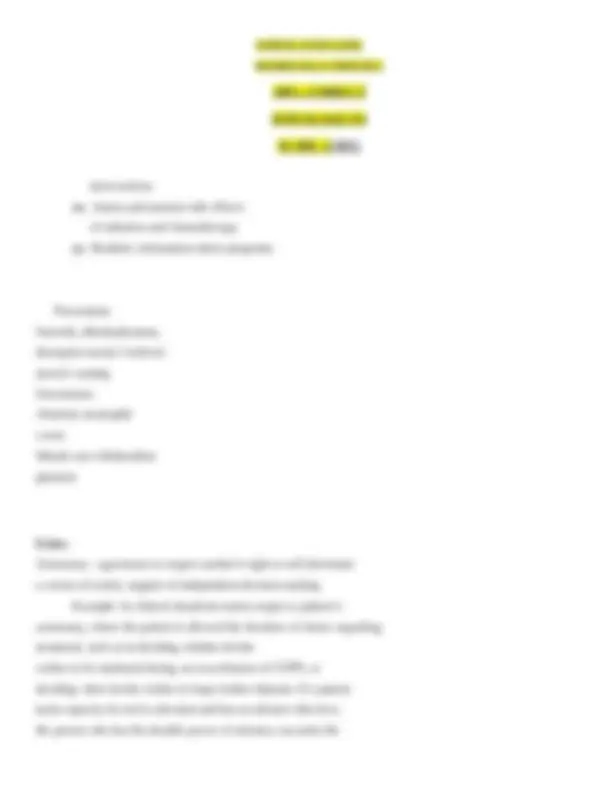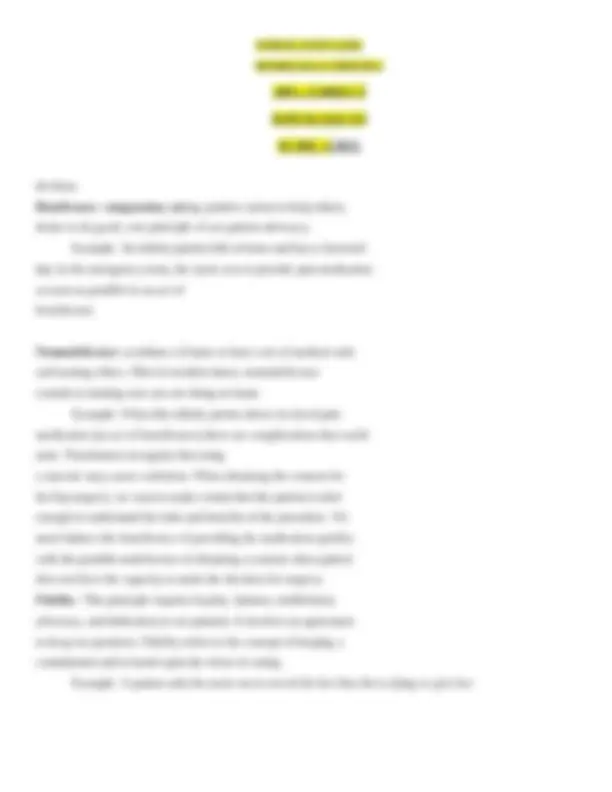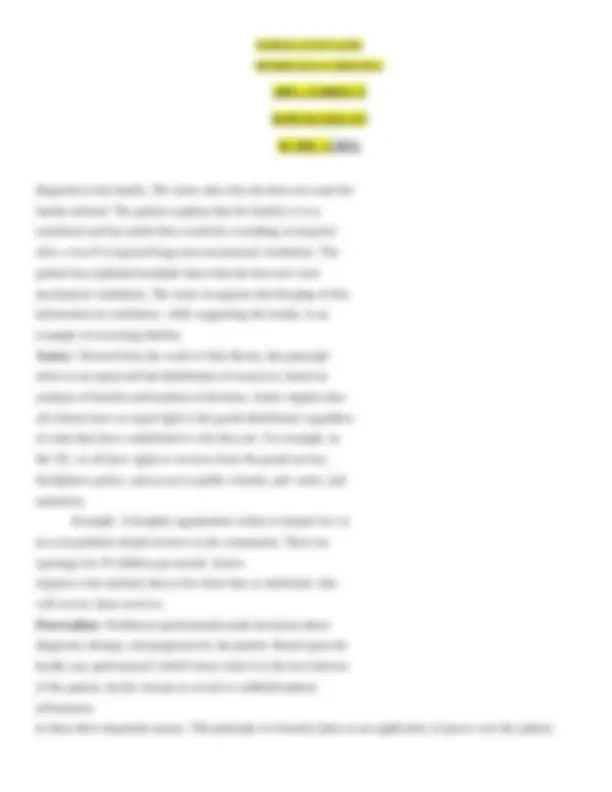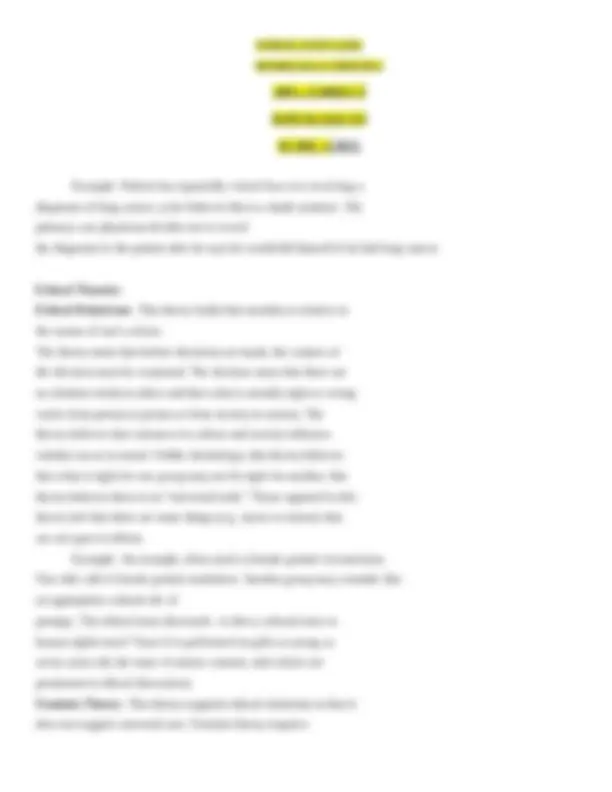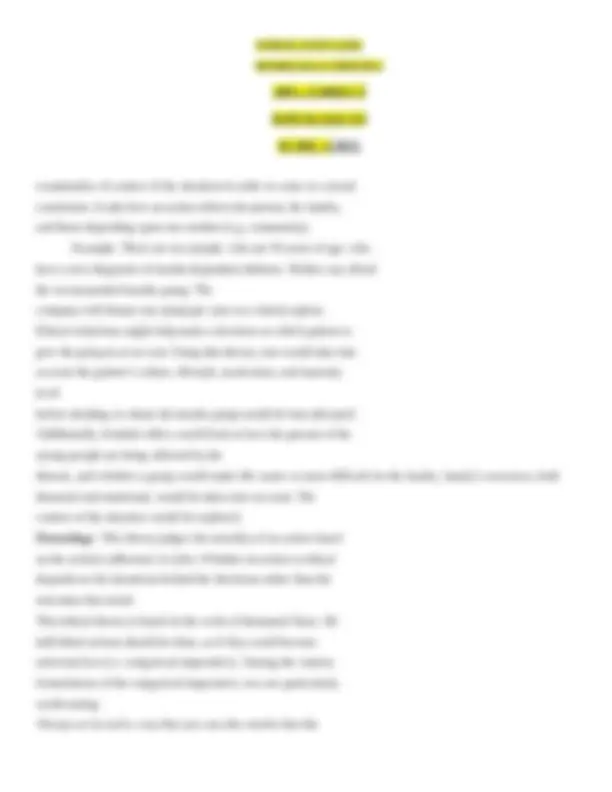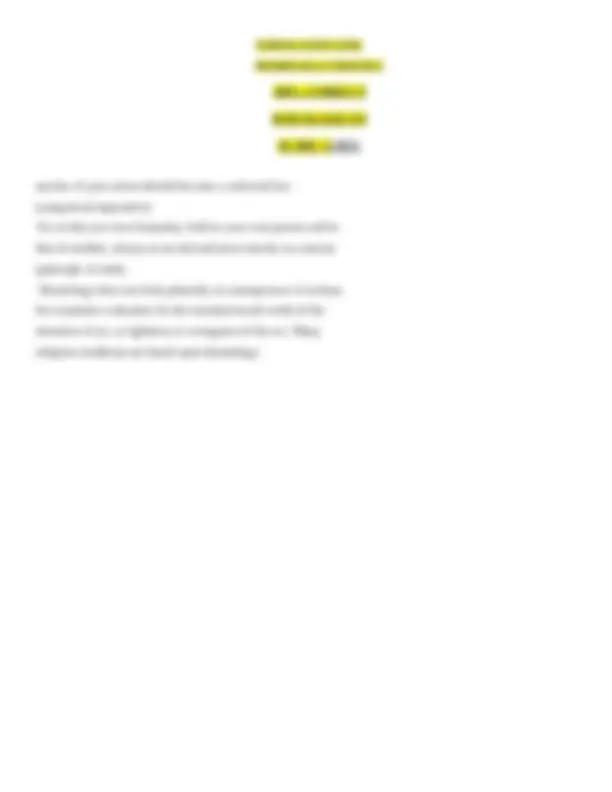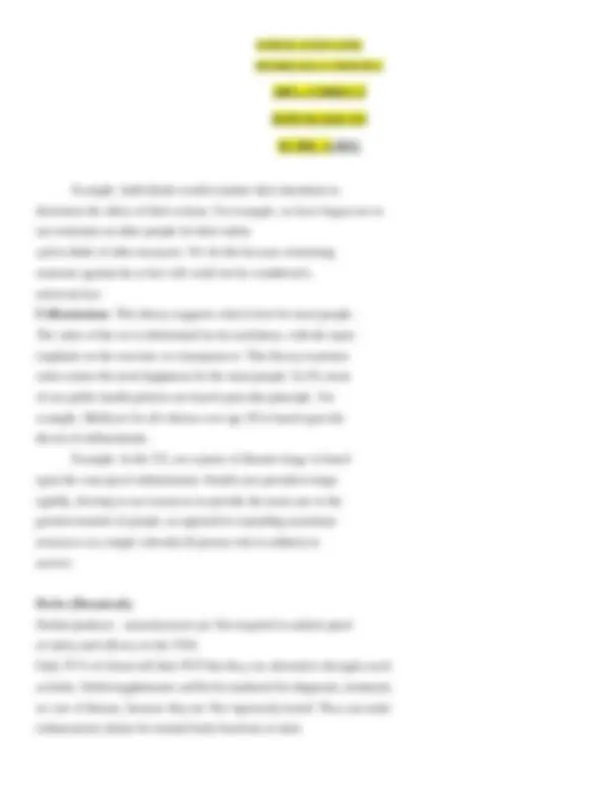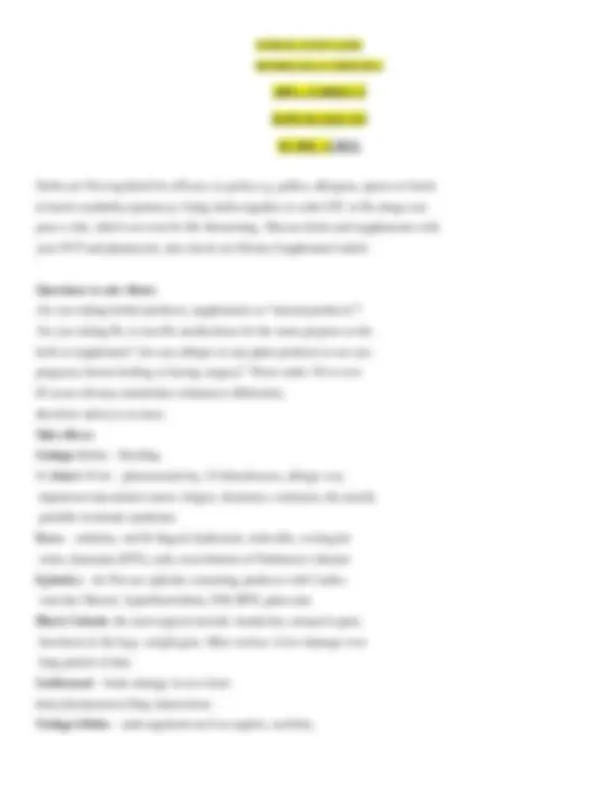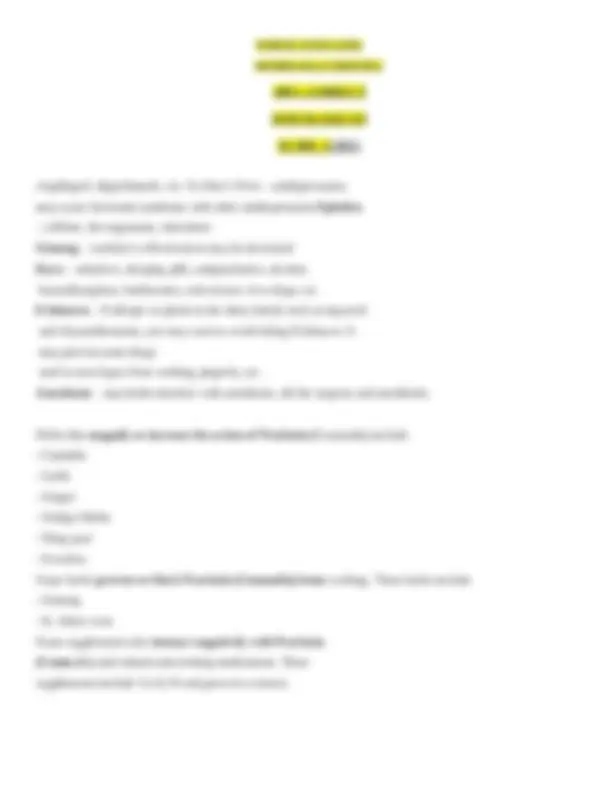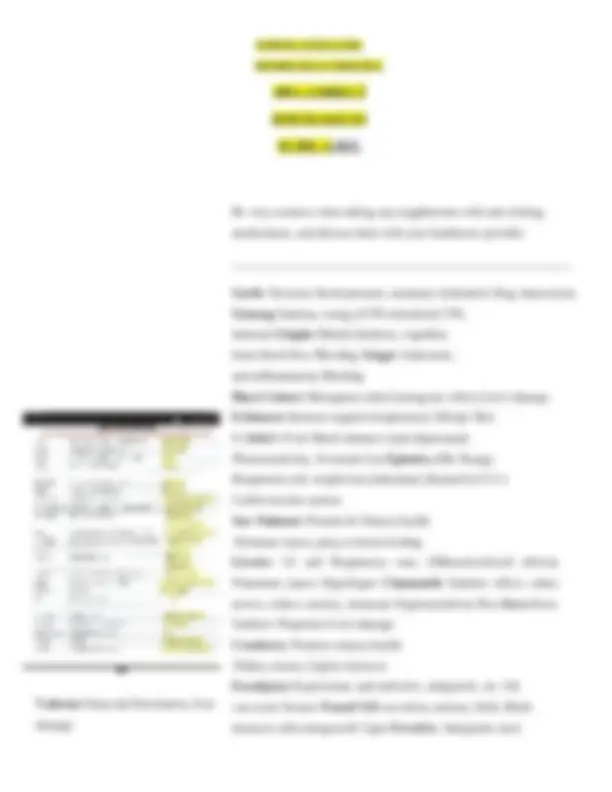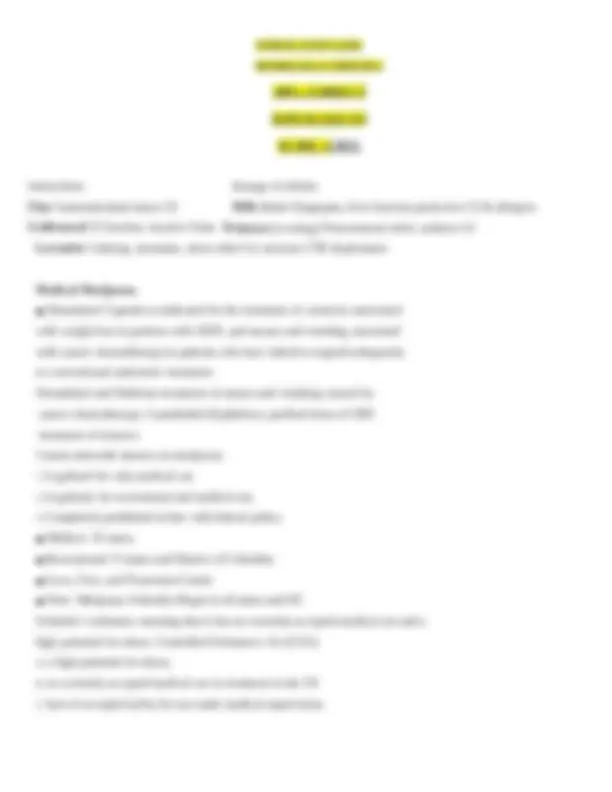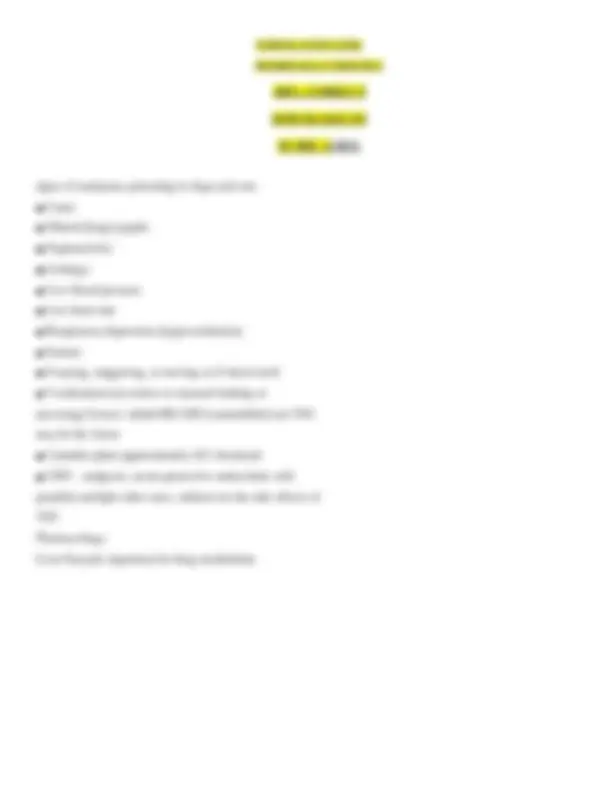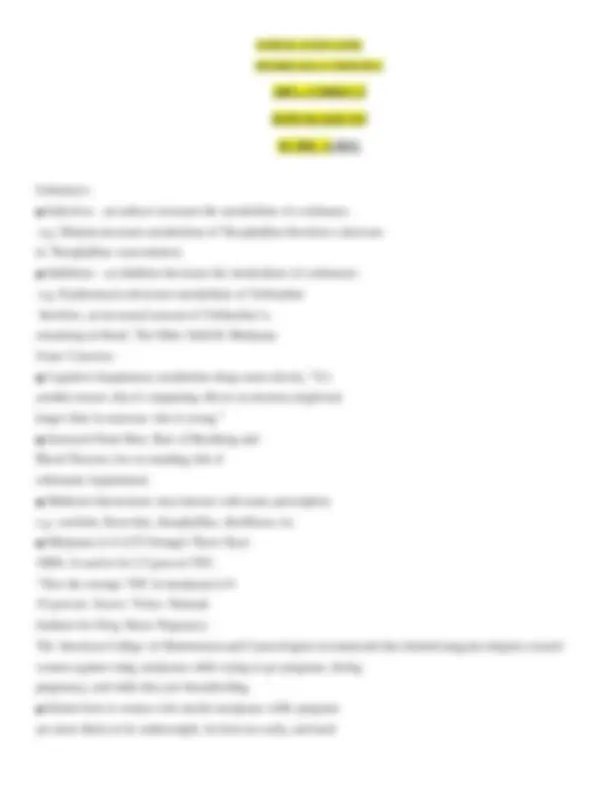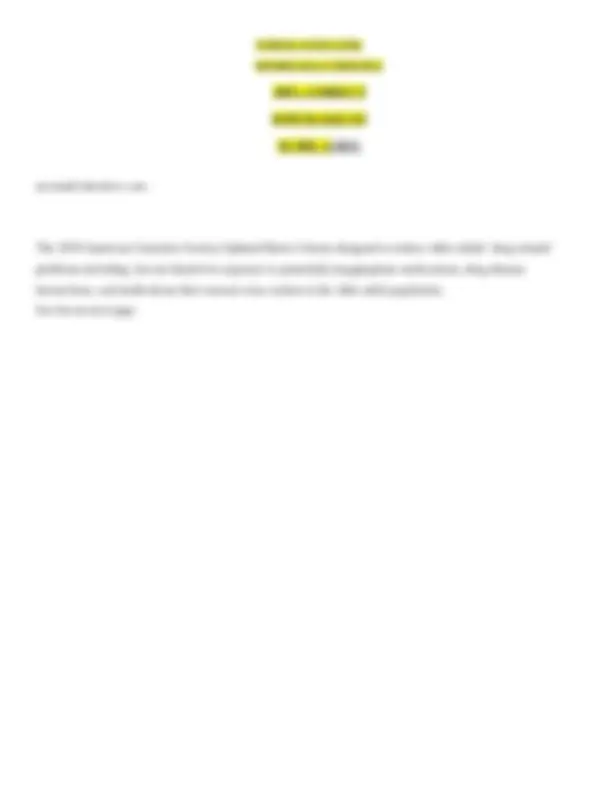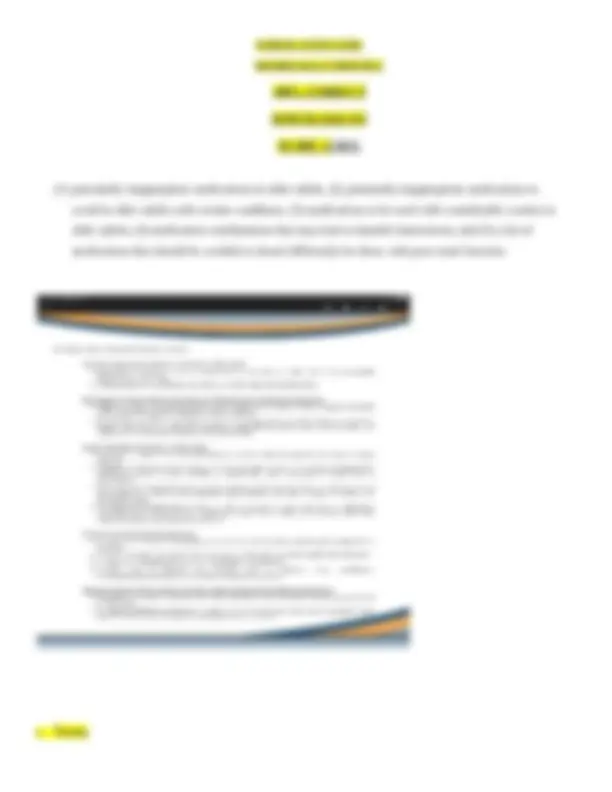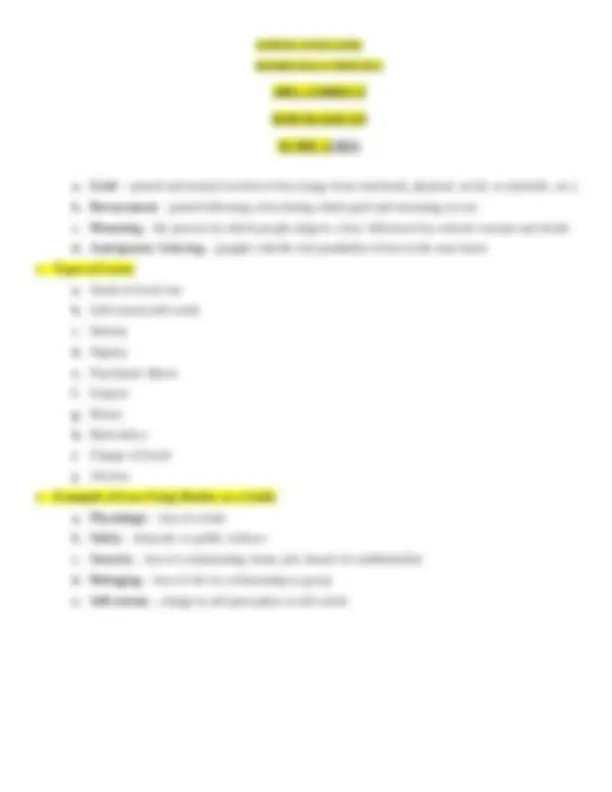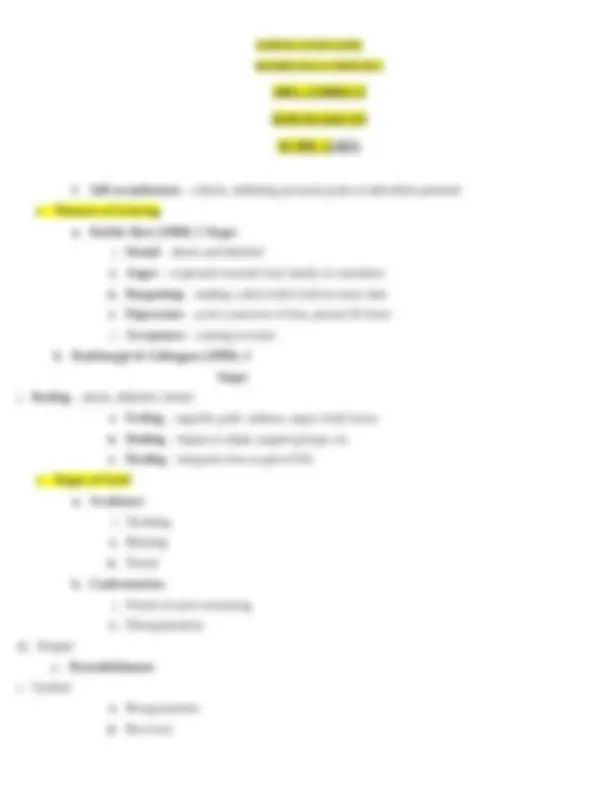Download NURSING STUDY GUIDE MONROE KELLY PRINCIPLE 100% CORRECT DOWNLOAD TO SCORE A/2023. and more Study Guides, Projects, Research Nursing in PDF only on Docsity!
MONROE KELLY PRINCIPLE 100% CORRECT DOWNLOAD TO SCORE A/2023. Nursing 231 – Test #2 Study Guide Monroe Kelly principle » Headaches «
- Types of Headaches Tension muscular, migraines, vascular and cluster neurological a. Migraines Headaches, recurrent episodic attacks of head pain Characteristics - Pain (throbbing, unilateral) - Nausea - Sensitivity to light - Based on the patient’s history, physical, neurological, and psychological assessment - Pain is unilateral, frontotemporal, throbbing pain behind one eye or ear Diagnosis - Atypical, sudden, severe, presence of neurological deficits, or over 50 - 2 Onset - (^) Meningitis, CSF leak, cerebral aneurysm, brain tumor - (^) Prolonged H/A
MONROE KELLY PRINCIPLE 100% CORRECT DOWNLOAD TO SCORE A/2023.
- Sinusitis, opioid dependence/withdrawal, caffeine withdrawal, overuse of OTC meds Tests MRI or CT scan
- Blood tests (CBC, anticoag tests for brain bleed)
- Lumbar puncture (nursing consideration: supine position and hydration to minimize spinal leak headache)
- EEG – nursing consideration- adhesive – use aspirin epilepsy.com Contributing factors
- (^) Familial
- (^) Occurs more in women (associated with menstrual cycles as trigger)
- (^) Stress or change in weather
- (^) Drugs
- (^) Hypoglycemia
- (^) Exercise
- (^) Diet – caffeine, red wine, monosodium glutamate (MSG) - Assessment o Assess the client to see what category of migraine they experience o Migraines with and without aura o Phases of migraine o Premonitory/Prodromal phase o Aura vision change o Vital Signs o Pain o ADLs o Photophobia, nausea, vertigo, and aura o Nutritional status
MONROE KELLY PRINCIPLE 100% CORRECT DOWNLOAD TO SCORE A/2023. o Triggers o Preventative measures
- REMEMBER SNOOPY acronym for HEADACHE RED FLAGS 3 R’s recognize respond relieve Interventions
- Pain management
- Teach patient to take meds during aura phase or early onset (NSAIDS, ibuprofen for mild migraines)
- Severe migraines: triptan preparations, ergotamine derivatives as needed (SHOULD NOT TAKEN BOTH TOGETHER)
- Teach patient about rebound headaches
- Complementary therapy: yoga, meditation, massage, exercise, acupuncture Medications for Migraines (abortive vs chronic) Nonspecific analgesics Acetaminophen, 3g per day livertoxic OTC worry, N/V, distended abdomen Nsaids kidney toxic. Take with food Butalbital Ibuprofen Naproxen – Saint Johns wort 3 g’s
MONROE KELLY PRINCIPLE 100% CORRECT DOWNLOAD TO SCORE A/2023. Ergot preg X Antihypertensive medications- beta blockers ( propranol ) and calcium channel blockers (amplodipine ) are used to prevent vasoconstriction or vasodilation in the cerebral blood vessels Antiepileptic Drugs (AEDs): Lisa specifically mentioned Topiramate and Valproic acids ( anticonvulsant and GABA increase) Do we have to know Side effects? Topiramate, seizure and migraine med. can increase body temperature and decrease sweating, leading to life-threatening dehydration, This medication can rarely cause a serious metabolic problem (high amount of ammonia in the blood), especially if you are also taking valproic acid. a. Phenytoin (Dilantin, anti-seizure. Slows down chemical msgs in brain)
- Triptans/Antimigraine Drugs Antimigraine (serotonin agonists; also called triptans) Triptan Preparations vasoconstriction, decreased pain 20-60 min, increase Bp, drowsiness, cardiovascular diseases caution anxiety, muscle pain a. Sumatriptan (Imitrex) i. Serotonin syndrome change in mental status. Hold med. Symptomatic management (ie. cool blanket and APAP for hyperthermia, IVF for hypotension) Stimulates 5-HT (5-hydroxytryptamine receptors) receptors in cerebral arteries, causing vasoconstriction and reducing headache symptoms Reduces the production of inflammatory neuropeptides
MONROE KELLY PRINCIPLE 100% CORRECT DOWNLOAD TO SCORE A/2023. Adverse Effects Triptans
- Vasoconstriction
- Tingling, flushing Drugs
- Ergotamine with caffeine (oral or suppository) (Cafergot, Migergot) It works by narrowing the blood vessels around the brain Ergot alkaloids Precaution : Ergotamine Preparations don’t use together With triptans
- Narrow or constrict blood vessels in the brain
- Were the mainstay of treatment of migraine headaches but have been replaced by the triptans for first-line therapy
- Dihydroergotamine mesylate (D.H.E. 45): injectable form and as a nasal spray (Migranal)
- Ergotamine tartrate with caffeine (Cafergot): tablet form - Side effects
- Nausea and vomiting
- Cold/clammy hands and feet
- Muscle pain
- Dizziness (More misc meds for migraines- not tested)
- Almotriptan (Axert) these are links!
- Eletriptan (Relpax)
- Naratriptan (Amerge)
- Rizatriptan (Maxalt)
- Zolmitriptan (Zomig)
- Frovatriptan (Frova)
MONROE KELLY PRINCIPLE 100% CORRECT DOWNLOAD TO SCORE A/2023.
- Dopamine receptor antagonist – Prochlorperazine, Dihydroergotamine preventative- Tricyclic antidepressants such as amitriptyline and imipramine (cardiac toxic – cautious use in heart diseases) imitrix
- Monoclonal antibodies -MABE preventative therapy
- Serotonin 1F receptor agonist (new med) – lasmiditan Abortive Therapy/Caffeine Combination of acetaminophen or aspirin plus the barbiturate butalbital plus the analeptic caffeine, with or without codeine (Fioricet) Excedrin to name a few Caffeine can potentiate the effect of the analgesics, can enhance intestinal absorption of the ergot alkaloids, and has a vasoconstricting effect; which can reduce cerebral blood flow, thus reducing the HA pain Has diuretic effect, which might also reduce cerebral blood flow Preventive Therapy Anticonvulsants medications ( lamotrigine and gabapentin ), increase the levels of many neurotransmitters and diminish pain impulses. Antidepressants are used to treat migraines by increasing serotonin and dopamine and norepinephrine These medications include: Selective serotonin reuptake inhibitors (citalopram, paroxetine, escitalopram, and fluoxetine) Serotonin/norepinephrine reuptake inhibitors such as duloxetine, venlafaxine and Tramadol Pain assessment. PIAOLDCART Treatment Focus on underlying causes Medications Lifestyle Modifications
MONROE KELLY PRINCIPLE 100% CORRECT DOWNLOAD TO SCORE A/2023.
- Develop between 20 and 50 years of age
- Cause and mechanism of action unknown; has been attributed to neurogenic inflammation
- Related to an overactive and enlarged hypothalamus Assessment
- Medications
- Relaxation techniques
- ALD’S
- SALT foods, nutrition
- Sleep/wake cycle
- Pain: unilateral , oculotemporal, oculofrontal HA; described as excruciating, boring, and non-throbbing
- May radiate to forehead, temple or cheek. How many.
- Less common to ear and neck
- Patient often paces, walks, sits and rocks during an attack ( this only occurs in cluster ) Defining characteristics
- Ipsilateral tearing of the eye - belonging to or occurring on the same side of the body
- Rhinorrhea
- Ptosis
- Eyelid edema
- Facial swelling
- Miosis
- Assess for bradycardia, flushing or pallor of the face, increased n/v, intraocular pressure, skin temp, restlessness and agitation Interventions
- Importance of sleep/wake cycles
- Medications
- Triptans, ergotamine preparations, CCBs, antiepileptic drugs
MONROE KELLY PRINCIPLE 100% CORRECT DOWNLOAD TO SCORE A/2023.
- Teach patient to wear sunglasses to avoid direct sunlight
- Teach patient to avoid triggers
- High flow O2 12L-15L for 15-20 minutes Tension Headaches (common but less severe) Characteristics
- Dull, aching head pain
- Sensation of tightness or pressure across the forehead or on the sides and back of head
- Tenderness on scalp, neck and shoulder muscles - No known etiology; stress is the most commonly reported trigger
- Episodic vs. chronic - Episodic o Can last from 30 minutes to a week o Described as band being squeezed around the head o Occurs more in women o Frequent episodic tension headaches occur less than 15 days/month for at least 3 months; frequent episodic HA can become chronic
- HA after a head injury
MONROE KELLY PRINCIPLE 100% CORRECT DOWNLOAD TO SCORE A/2023. » Brain Tumors «
SYMPTOMS
Originate from brain cells, meninges, nerves, and glands Types: ●Gliomas ●Meningiomas ●Oligodendroglimos ●Acoustic neuromas ●Pituitary tumors Location
- Primary tumors originate within central nervous system (CNS).
- Secondary tumors from metastasis in other parts of body Classification Primarily classified as benign, malignant, metastatic Secondary classification is based on location - Supratentorial : tumors that located within the cerebral hemispheres - Infratentorial : tumors in the area of the brainstem structures and cerebellum (infratentorial area beneath the tentorium) Third classification depends on the cellular or anatomic origins of the tumor; this classification is mostly used for classifying gliomas… Gliomas are malignant tumors Grouped by Grade Grade I - tissue is benign; cells look nearly like normal brain cells, grow slowly Grade II - tissue is malignant; cells look less like normal cells
MONROE KELLY PRINCIPLE 100% CORRECT DOWNLOAD TO SCORE A/2023. Grade III - malignant tissue has cells that look very different from normal cell Grade IV - malignant tissue has cells that look most abnormal and tend to grow quickly Glioma is a common type of tumor originating in the brain. About 33 percent of all brain tumors are gliomas, which originate in the glial cells that surround and support neurons in the brain, including:
**- astrocytes,
- oligodendrocytes
- ependymal cells Astrocytoma** are glial cell tumors developed from connective tissue cells called astrocytes. They are most often found in the cerebrum (the large, outer part of the brain), but also in the cerebellum (located at the base of the brain). Astrocytoma can develop in adults or in children. glioblastoma multiform e, are the most malignant of all brain tumors High-grade astrocytoma, called Glioblastoma symptoms are often the same as those of other gliomas
- Poor survival rate
- There is no obvious cause of glioma
- They can occur in people of all ages but are more common in adults
- Gliomas are slightly more likely to affect men than women Meningiomas Most common benign tumor arise from covering of the brain (meninges); this tumor tends to recur Adenoma Pituitary tumor that occur in the anterior lobe and may cause endocrine dysfunction, Pituitary tumors – endocrine. Hypersecretion of growth hormone acromegaly amenorrhea, changes on urine output Acoustic neuromas
MONROE KELLY PRINCIPLE 100% CORRECT DOWNLOAD TO SCORE A/2023. Oligodendrogliomas
1. Characteristics - Etiology unknown; possible genetic mutations and possible environmental factors - Primary brain tumors are uncommon, most patients have metastatic lesions - Malignant brain tumors seen primarily in patients 40-70 years of age - Account for a small percentage of cancer deaths. - Survival rate – poor - Regardless of location, tumor expands and invades, infiltrates, compresses, and displaces normal brain tissue - Can lead to cerebral edema KAPLAN DELEGATION AND PRIORITIZATION: 132 NATL DELEGATION TERMINOLGY IDIOSCYANCES 2. Assessment - Assess for SS of HAs, visual disturbances, seizures - Tentorium- fold of the dura mater - Supratentorial tumors- usually result in paralysis, seizures, memory loss, cognitive impairment, language impairment, vision problems - Infratentorial- produce ataxia, autonomic nervous system dysfunction, vomiting, drooling, hearing loss - Assess for ICP 3. Neurological Assessment ●Vital Signs: early sign of mental status changes ●Widening pulse pressure (highly elevated SBP and low DPB) ●Cushing's Triad (HTN, bradycardia, and irregular respiration – late sign of cerebral herniation pressure on spinal cord; remember 2 posturing signs) ●Intake and urinary output
MONROE KELLY PRINCIPLE 100% CORRECT DOWNLOAD TO SCORE A/2023. ●Urine specific gravity and osmolality ●Serum sodium and osmolality ●Pain
4. Complications. - Cerebral edema/brain tissue inflammation - ICP - Pituitary dysfunction- SIADH/DI, severe fluid and electrolyte imbalance - Neurologic deficits - Hydrocephalus r/t obstruction of CSF flow - - Herniation decorticate- flexion , decerebrate – extension - Cushing’s triad. - SIADH vs Diabetes INCIPIDIS o Caused by: Tumors Damaged to the hypothalamus or pituitary gland Infection/germs (PNA, meningitis) Central neuro issues: strokes, gullian-barre syndrome Syndrome of Inappropriate Antidiuretic Hormone (SIADH) : There is a high level of ADH (antidiuretic hormone) produced acronym SIADH….S I ncreased ADH (anti-diuretic hormone) High Level of ADH equals low urinary output. Hypernatremia
MONROE KELLY PRINCIPLE 100% CORRECT DOWNLOAD TO SCORE A/2023. e. Phenytoin. Not discussed. Anti seizure f. Ranitidine hydrochloride, risk for GI bleed g. Stereotactic radiosurgery h. Craniotomy
- Performed under local or general anesthesia or sedation
- Burr holes drilled into the skull and a saw is used to remove a piece of the bone to expose the tumor area. Bone flap is replaced and held together by small screws of holes - Post-Op Care/Interventions ▪ Cold compress to eyes (ecchymosis and ▪ edema are not unusual) ▪ Irrigate eye with warm normal saline or ▪ artificial tears to increase comfort ▪ Maintain cardiac monitoring ▪ F/E imbalance ▪ Record I/Os for 1 st^24 hours, fluid restriction ▪ 1500 ml if there is pituitary involvement ▪ Reposition patient- don’t turn on operative side ▪ Supratentorial surgery- elevate HOB to 30 degrees ▪ or as tolerated to promote venous drainage ▪ Patients remain NPO for 24 hours post op ▪ Check head dressing q 1-2 hours for signs of drainage ▪ VTE prophylaxis ▪ Monitor labs hgb, CBC, wbc ▪ Administer routine post-up medications Histamine blockers or proton pump inhibitors for stress ulcer prophylaxis Glucocorticoids
MONROE KELLY PRINCIPLE 100% CORRECT DOWNLOAD TO SCORE A/2023. Acetaminophen Post-Op Complications Increased intracranial pressure Assess patient for S/S of increased ICP
- Non-pharm interventions: NEUTRAL head position; HOB 30-35 degree
- Pharmacological intervention: osmotic diuretic Mannitol, hyPERtonic 3% saline) Administer medications that decrease cerebral edema, and increased ICP (important to maintain balance of ICP and cerebral perfusion pressure CPP) Bleeding Cerebral Edema Seizures Venous Thromboembolism landmarks for injections 2 inches from umbilus etc…enoxiparim injection don’t expel air, 45 degree when pinching fat 90 if not General Interventions Medications ●Steroids, Monitor serum electrolytes, particularly sodium SIADH and glucose steroids raise potassium and sodium SIADH ●Stool softners ●Antiepileptics INSULIN LISPRO POTASSIUM RATE OF INFUSION 10MEQ PER HOUR MAGNESIUM NEEDS TO BE CORRECTED BEFORE POTASSIUM


